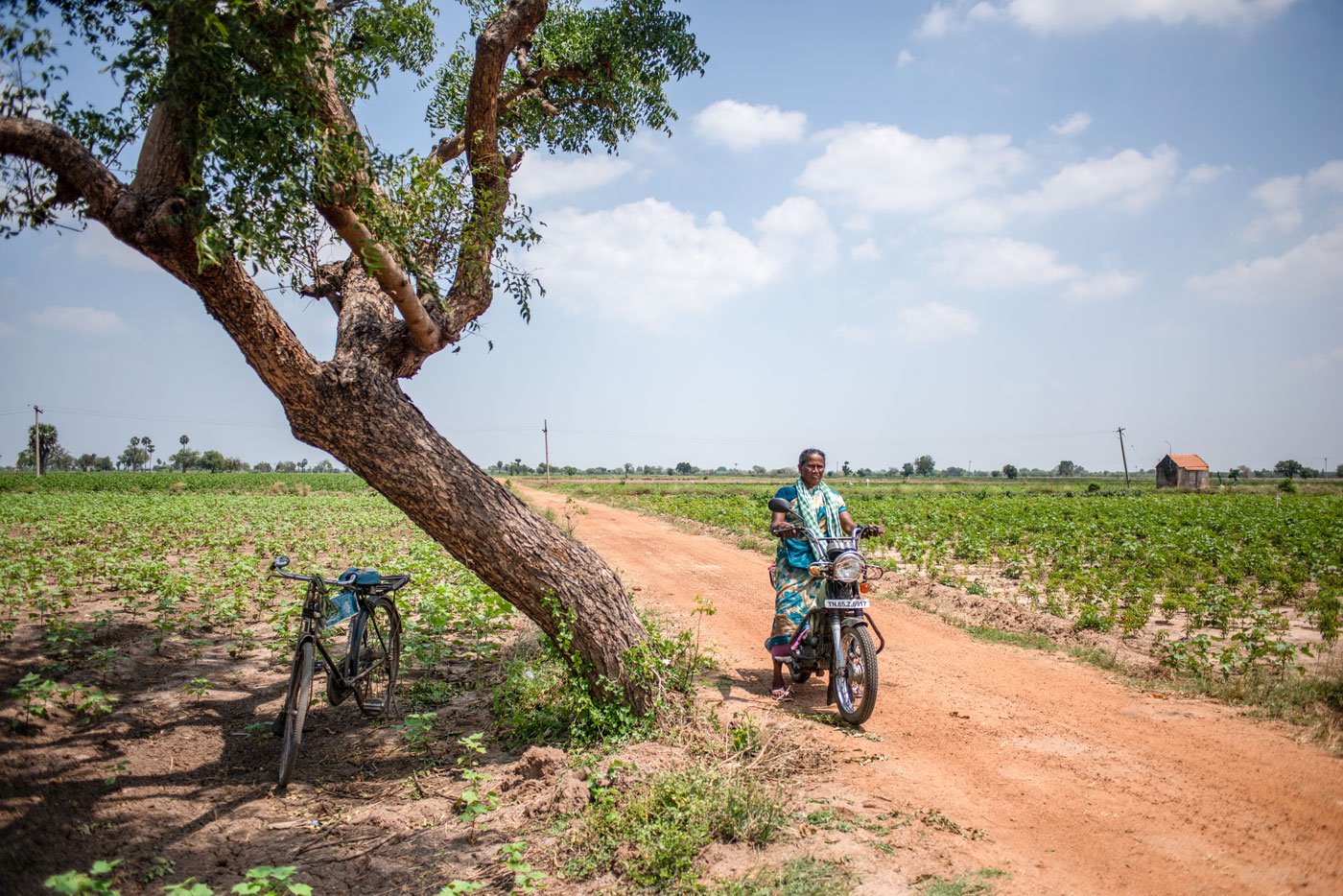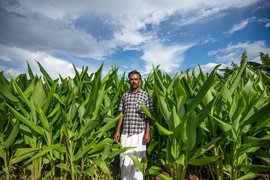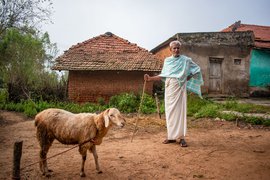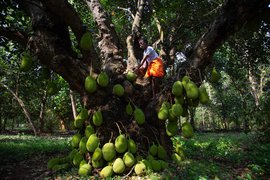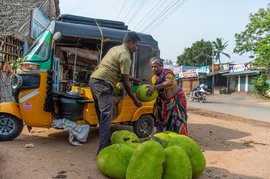There’s a small cloud of dust, and the phut-phut of an engine: Adaikalaselvi comes riding on a bike, wearing a blue saree, a big nose ring, and a wide smile. A few minutes earlier, she had instructed us – from her chilli fields – to wait outside her locked house. It is high noon and only March as yet, but the Ramanathapuram sun is ferocious. Our shadows are small, our thirst is large. Parking the two-wheeler in the sweet shade of a guava tree, Adaikalaselvi quickly opens the front door and invites us in. The church bell rings. She brings us water; we sit down for a chat.
We start with her bike. It’s not very common for a woman of her age, from a small village, to drive one. “But it is so useful,” laughs the 51-year old. She learnt it very quickly. “My brother taught me when I was in eighth standard. I knew cycling, so it wasn’t hard.”
If not for the two-wheeler, life would have been harder, she points out. “My husband was away from home for many years. He worked as a plumber, first in Singapore and then in Dubai and Qatar. I raised my daughters and ran the farm.” Single-handedly.
J. Adaikalaselvi has always been a farmer. She sits cross-legged on the floor, her back erect, her hands – each adorned with a single bangle – resting on her knees. She was born into an agricultural family, in Kalayarkoil, Sivagangai district. It’s an hour and a half away by road, from her hamlet P. Muthuvijayapuram, in Mudukulathur block. “My brothers live in Sivagangai. There they have many borewells. And here, I buy water for irrigation at 50 rupees an hour.” Water is big business in Ramanathapuram.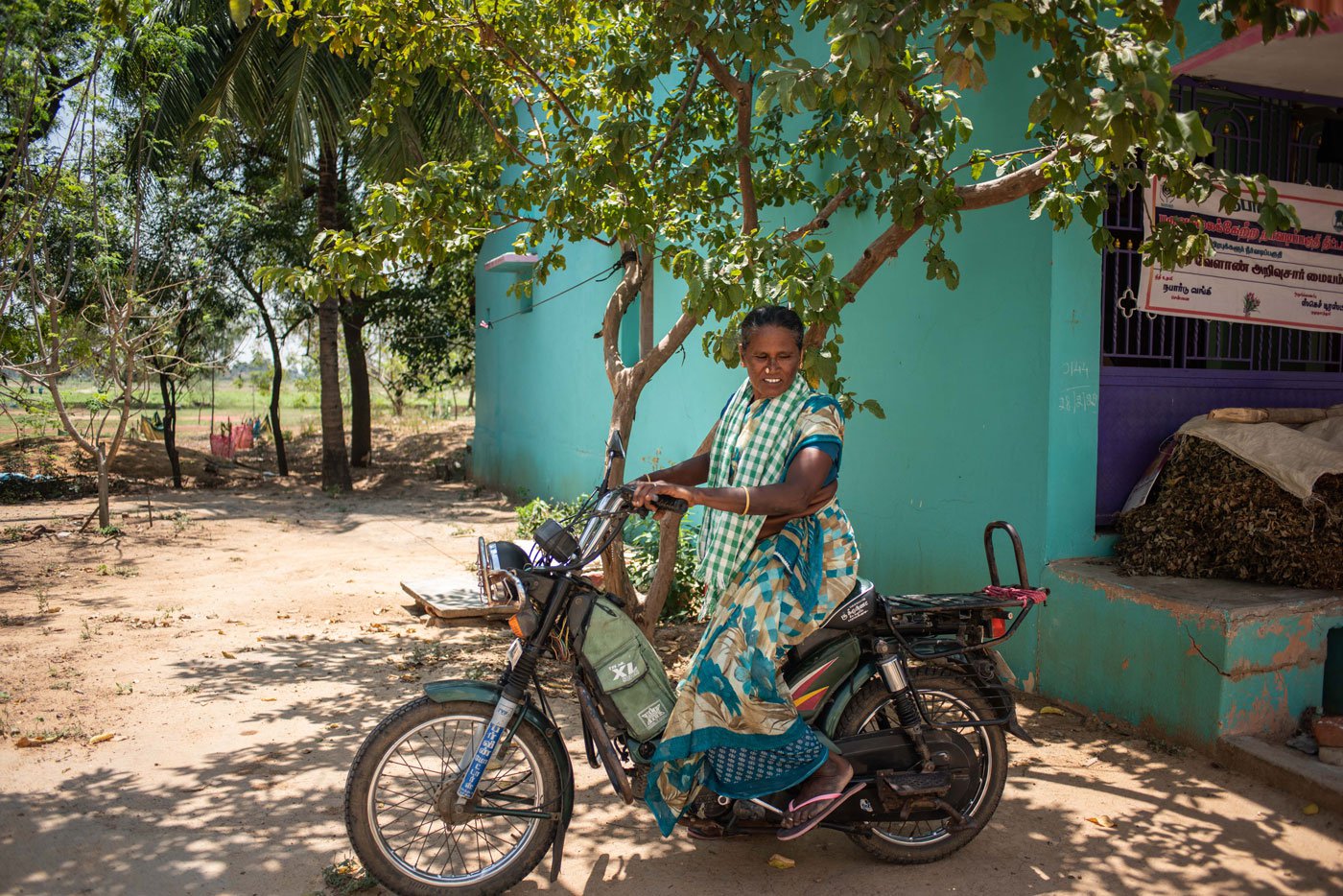
Adaikalaselvi is parking her bike under the sweet guava tree
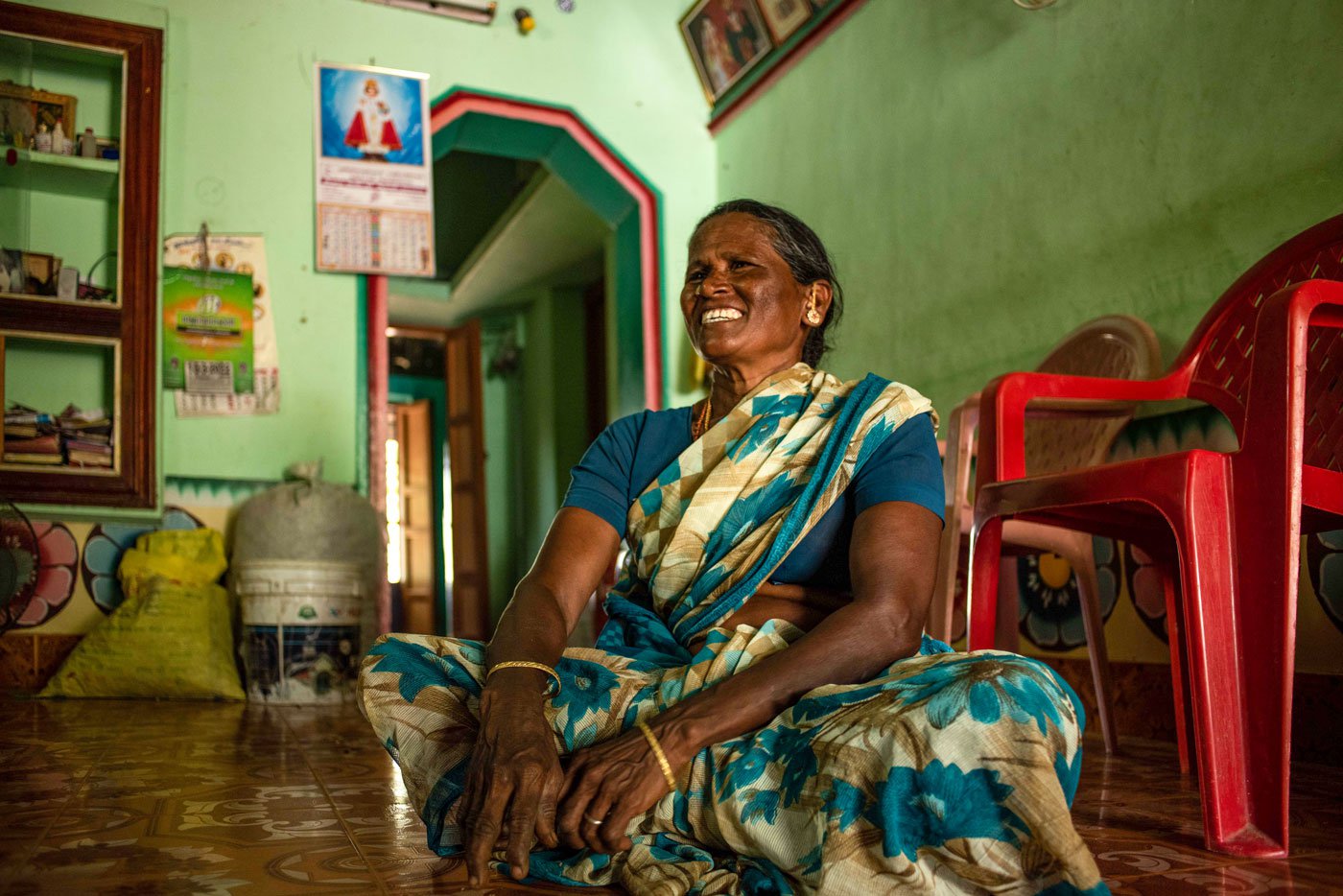
Speaking to us in the living room of her house in Ramanathapuram, which she has designed herself
When her daughters were young, Adaikalaselvi put them in a hostel. She’d finish work in the field, go over to see them, come back, and run her house. Now she farms six acres of land, owning one and leasing the other five. “Paddy, chilli, cotton: that’s for the market. And coriander, ladies’ finger, brinjal, gourds, small onion: that’s for the kitchen…”
She points to a loft in the hall. “I put away the paddy in sacks up there so that rats can’t get it. And the chilli goes into the loft in the kitchen.” That way, she says, there’s moving room in the house. She designed these features herself, she tells me with a shy smile, over two decades ago, when the house was built. And it was her idea to carve Mother Mary on the front door. It’s a beautiful wood carving, with Mary standing on top of a flower. Inside the living room, the pista green walls are decorated with more flowers, photographs of her family and portraits of Jesus and Mary.
Besides the aesthetics, the ample storage in her house gives her a chance to keep her harvest and wait for a good price. Mostly it pays off. The government procurement rate for paddy was Rs. 19.40.
Whereas the local commission agent only offered 13. “I sold two quintals [200 kgs] to the government. Why can’t they buy chilli too?” she asks.
Every chilli farmer would appreciate a steady, good price, she argues. “Unlike paddy, chilli can’t take much rain or standing water. This year, it rained when it shouldn’t have – when the plants germinated, when they were small saplings. And when some rain would have helped – before the flowering – there was none.” She didn’t use the word ‘climate change’ but alluded to the changing pattern of rain – too much, too quickly, in the wrong season, at the wrong time. Thanks to that, her yield, she estimated, was down to a fifth of her usual harvest. “It’s going to be a washout.” And this, despite the ‘high price’ of over Rs. 300 a kilo for the ‘Ramnad mundu ’ variety she raises.
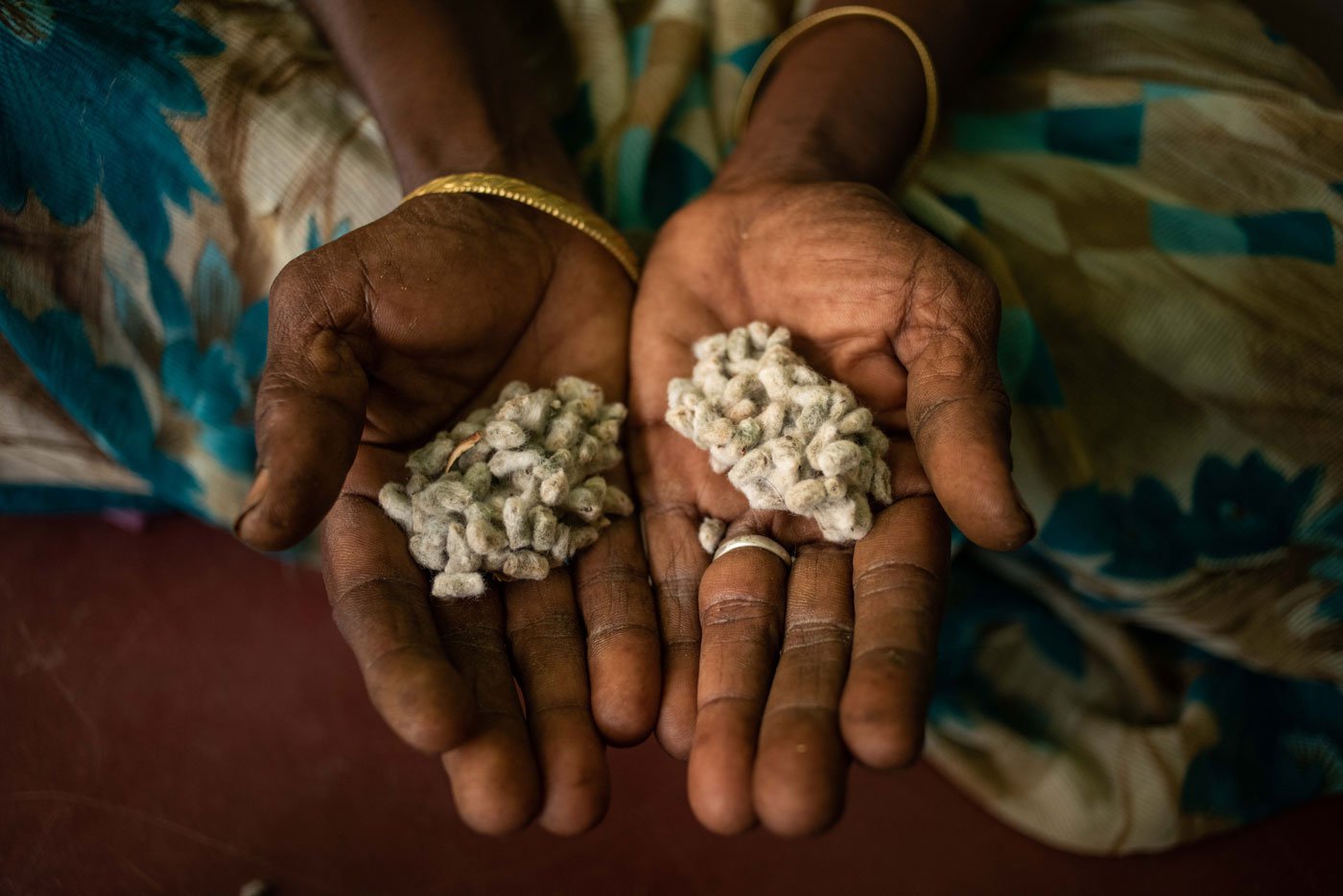
Adaikalaselvi is showing us her cotton seeds. Since last ten years she has been saving and selling these
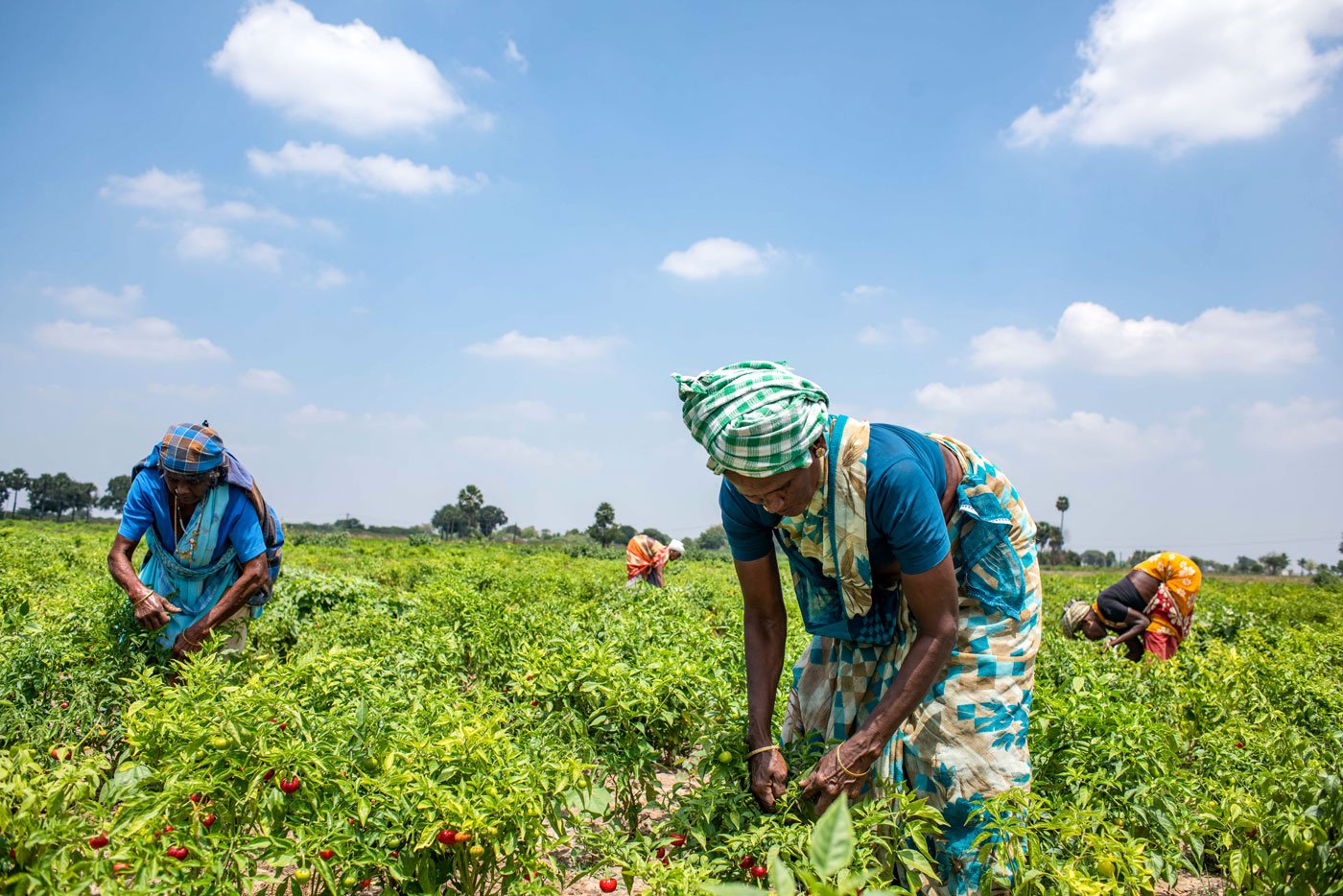
She is plucking chillies in her fields
She remembers when chilli went for one or two rupees a measure. And brinjal was sold for 25 paise, a kilogram. “Why, cotton was just three or four rupees a kilo, thirty years ago. Then again, you could hire labour at five rupees a day. Now? That’s gone up to 250 rupees. But cotton only fetches 80 a kilo.” In other words, the cost of labour has grown 50 times; the selling price just 20 times. What’s a farmer to do? Keep calm and carry on, apparently.
Adaikalaselvi does that anyway. Her resolve is visible when she speaks. “The chilli field is this side,” she points to the right, “and I farm some land over there, and some more that side.” Her hands draw patterns in the air. “Because I have my bike, I even come back for lunch. And I don’t depend on a man to fetch and carry the sacks. I just put them on the carrier and bring it home.” Adaikalaselvi smiles as she speaks, and the Tamil of her region is at once familiar and distinctive.
“Until I bought my bike in 2005, I used to borrow one from someone in the village.” She considers her TVS moped a great investment. Now, she encourages young women in the village to drive. “Many do, already,” she smiles, climbing back on the bike, to go to her field. We follow her in our vehicle, past a harvest of chillies drying in the sun, a red carpet in Ramanathapuram, that will spice up a meal far away, one gundu milagai (fat chilli) at a time…
*****
“I saw you green, then turning redder as you ripened,
nice to look at and tasty in a dish…”
From a song by saint-composer Purandaradasa
This interesting line – open, surely, to many interpretations – was the first literary mention of chillies, says K. T. Achaya in his book ‘Indian Food, A Historical Companion.’ The spice, he adds, is so ubiquitous in Indian food, it is “difficult to believe it has not always been with us.” The song, meanwhile, gives us an approximate date: it was a composition by the “great south Indian composer Purandaradasa, who lived between 1480 and 1564.”
The song goes on to say:
“Saviour of the poor, enhancer of good food, fiery when bitten, even to think of (the deity) Panduranga Vittala is difficult.”
Capsicum annum as chilli is called, ‘travelled to India with the Portuguese who brought it from their South American conquests to the shores of India,’ say Sunita Gogate and Sunil Jalihal in their book ‘ Romancing the Chilli .’
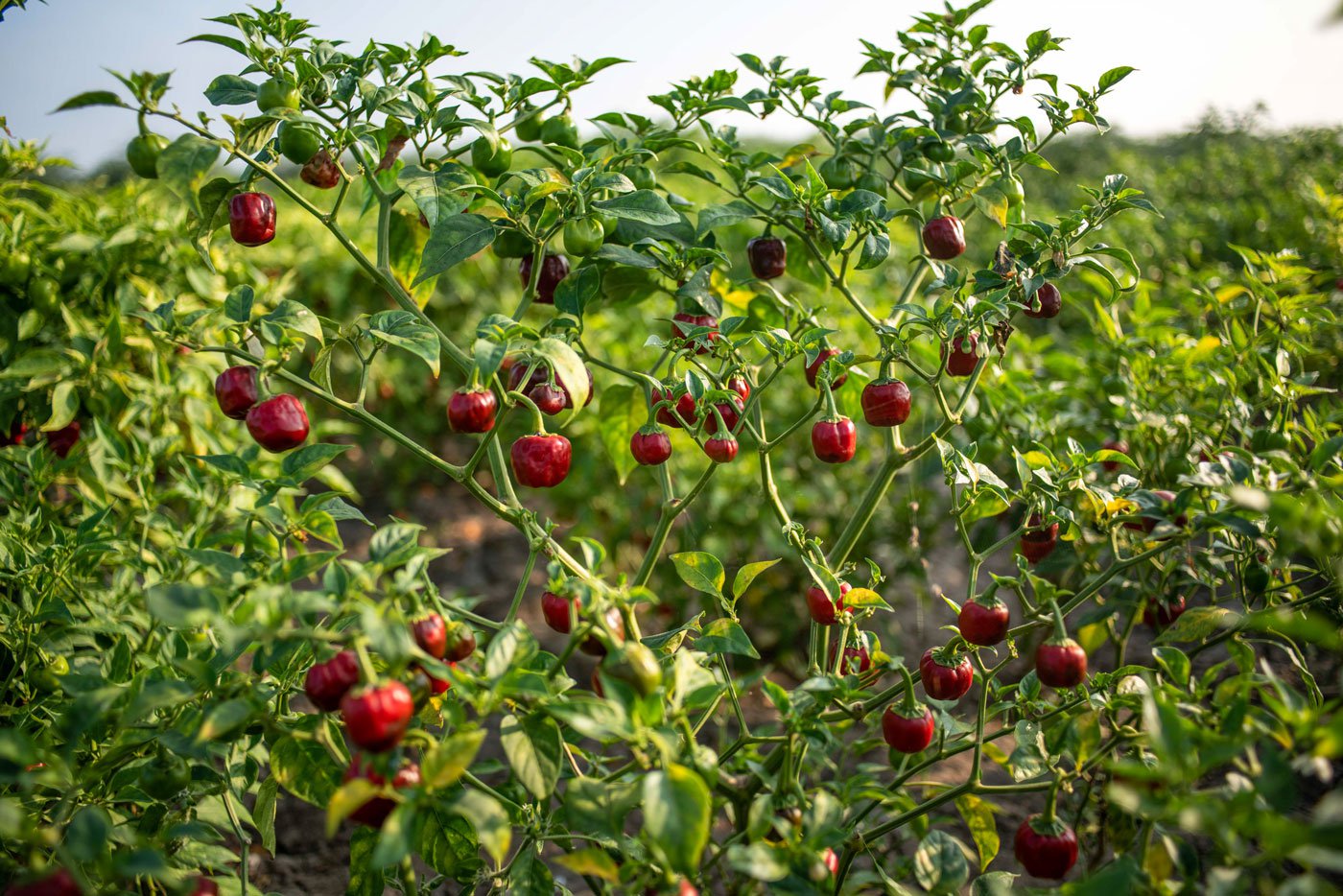
A popular crop in the district, mundu chillies, ripe for picking
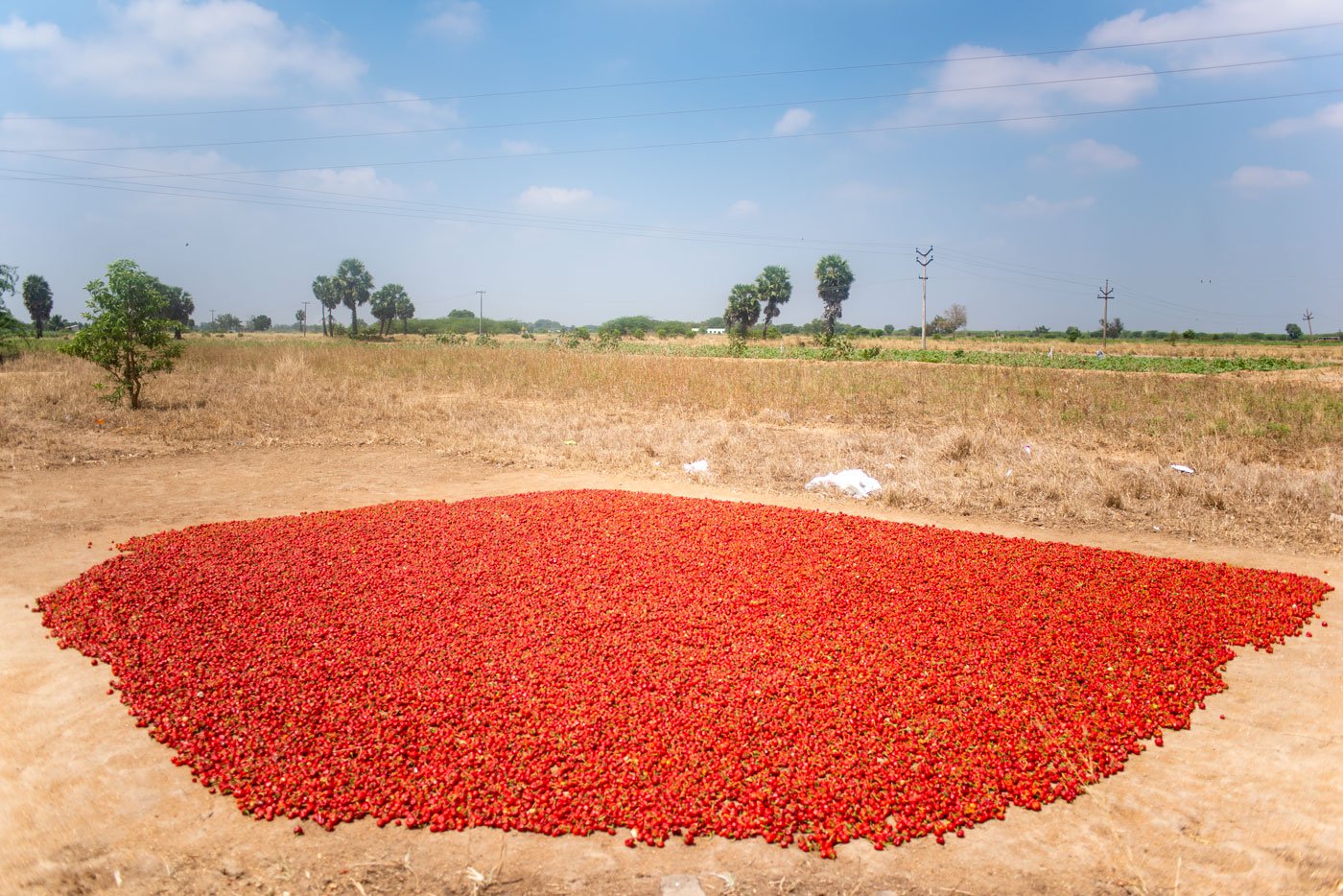
A harvest of chillies drying in the sun, red carpets of Ramanathapuram
And once it got here, it quickly surpassed pepper – until then the only spice that added ‘heat’ to food – because it “could be grown all over the country…with a versatility much greater than that of pepper,” points out Achaya. Perhaps as a nod, chilli – in many Indian languages – was named after pepper. In Tamil, for instance, pepper is milagu ; chilli became milagai , two vowels bridging continents and centuries.
The new spice became ours. And today, India is among the world’s largest producers of dried red chillies, and the leader in the Asia-Pacific region, with 1.7 million tonnes in 2020. That’s nearly five times more than Thailand and China, who are placed second and third. In India , Andhra Pradesh is easily the ‘hottest’ state, producing 8,36,000 tons in 2021. Tamil Nadu produced just 25,648 tons the same year. Within the state , it is Ramanathapuram that leads the roster: one in every four hectares (15,939 out of 54,231) where chilli is grown in Tamil Nadu is from this district.
I first read about the chillies and farmers of Ramanathapuram in a chapter titled “The tyranny of the tharagar ,” in journalist P. Sainath’s classic: Everybody Loves a Good Drought . The story opens this way: “the tharagar (commission agent) dips his hands into one of two sacks laid before him by a small farmer and extracts a kilogram of chillies. This he carelessly tosses to one side – as sami vathal (God’s share).”
Sainath then introduces us to the stunned Ramaswamy, “the chilli farmer eking out a living on three-quarters of an acre,” who cannot sell his produce to anybody else, because the agent had bought the “entire crop even before it was sown.” Such was the hold of the tharagar over farmers in the early 1990’s, when Sainath toured ten of the poorest districts in the country for his book.
And, in 2022, I went back to Ramanathapuram, for my series ‘Let Them Eat Rice’, to find out how chilli farmers now fared.
*****
“The reasons for low yield: Mayil, muyal, maadu, maan, (in Tamil – peacock, rabbit, cow, and deer). And then there is too much rain or too little.”
V. Govindarajan, chilli farmer, Mummudisathan, Ramanathapuram
Inside the chilli trader’s shop in Ramanathapuram town, women and men are waiting for the auction to begin. They are all farmers who have travelled to this market in tempos and buses, and they sit on sacks of cattle feed (‘Double Horse’ brand) fanning themselves with their pallus and towels. It is very hot, but at least, they point out, there is some shade. In their fields, there is none. Chilli plants don’t thrive in the shade, you see.
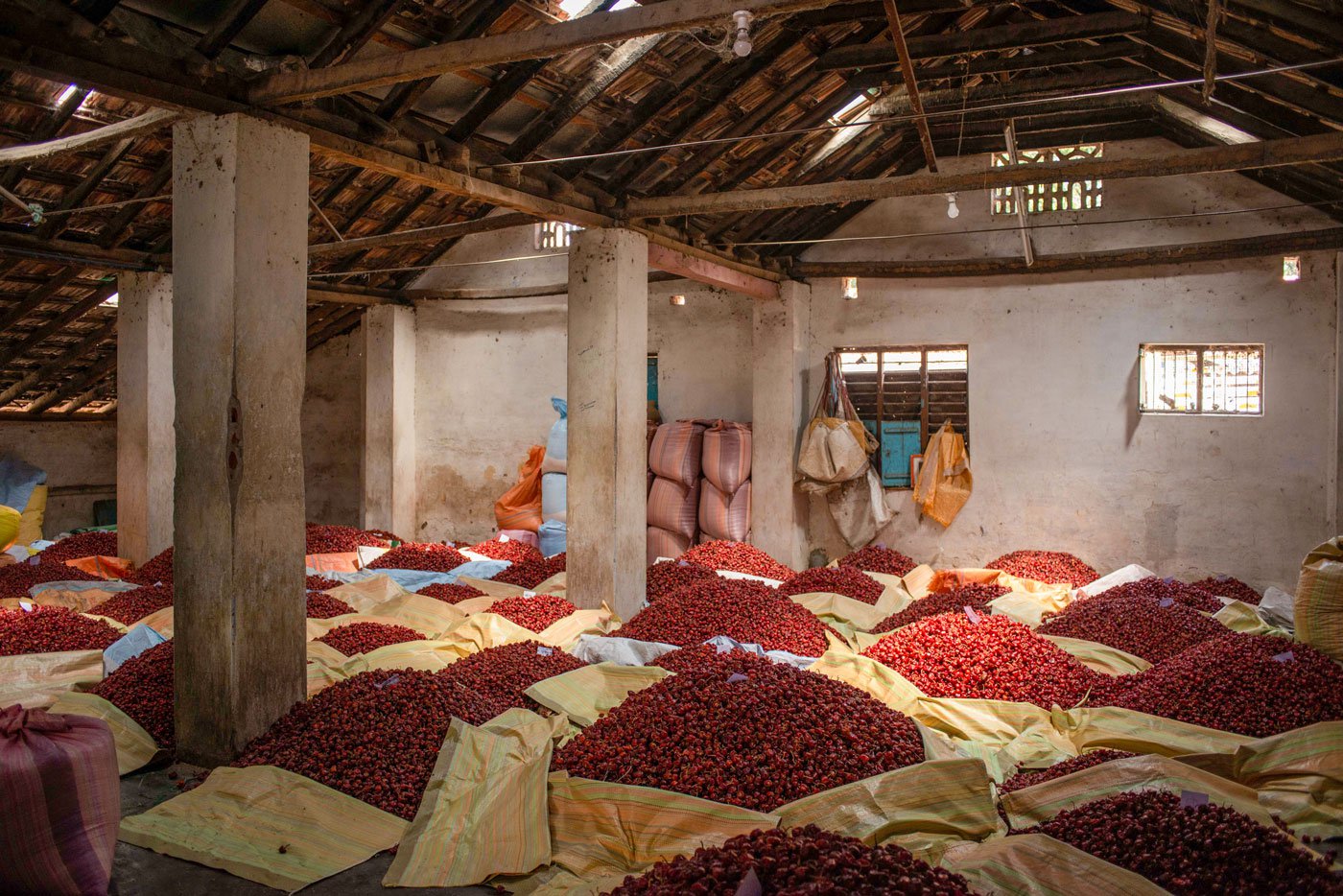
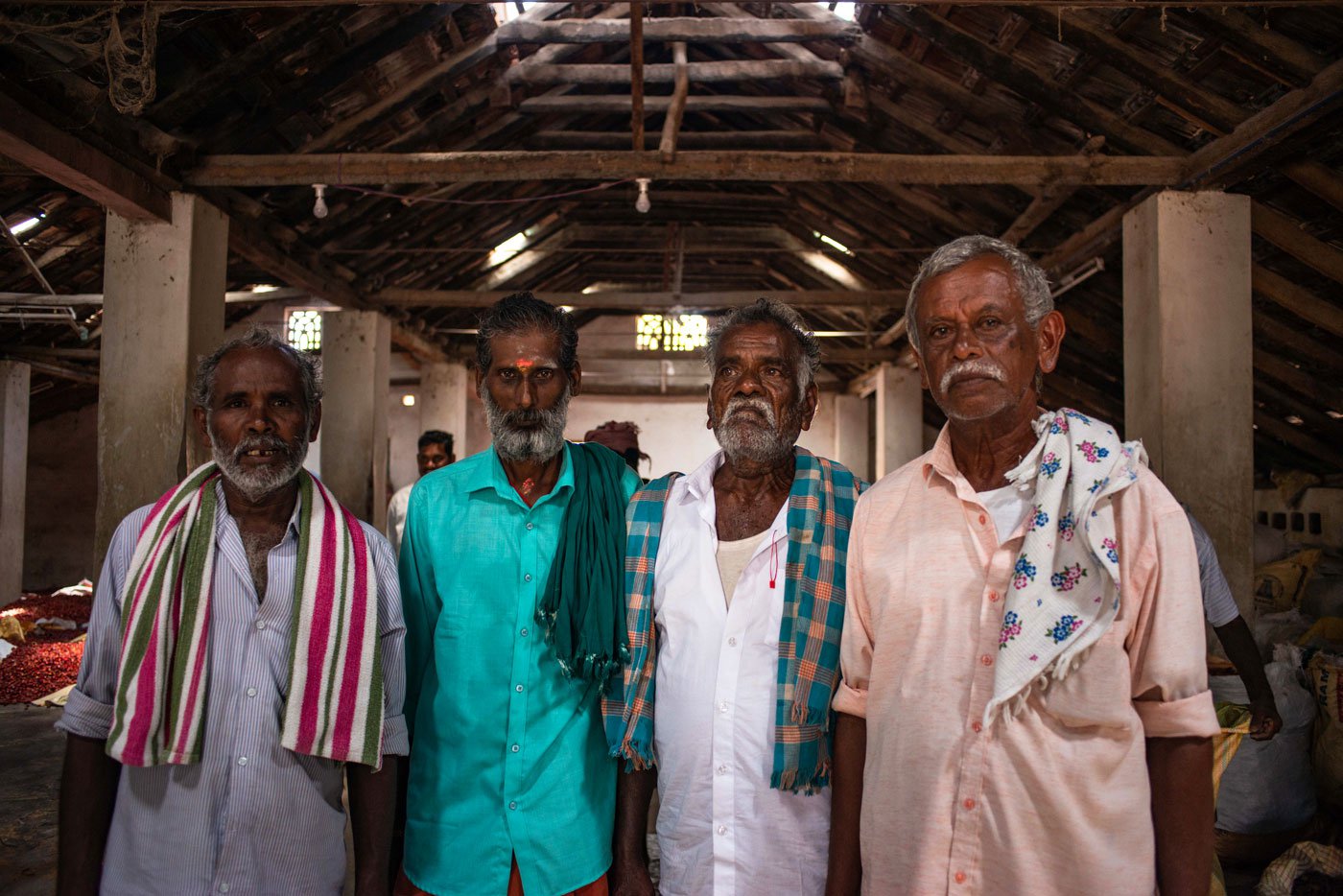
Left: Mundu chilli harvest at a traders shop in Ramanathapuram. Right: Govindarajan (extreme right) waits with other chilli farmers in the traders shop with their crop
V. Govindarajan, 69, has brought three sacks of red chillies, 20 kilos each. “This year, the harvest is poor.” He shakes his head when he talks about the magasool , harvest. “But none of the other costs are coming down.” The crop itself is fairly hardy, he says. Compared to other fussy crops like malligai (jasmine), milagai does not need to be bathed in pesticides.
Next, Govindarajan talks about the process. He gives me a breakdown of the number of ploughings: seven (that’s two deep ploughings and five summer ploughings). Next comes the fertilizer. That is, penning 100 goats each night for a week on his field so that their manure enriches the soil. This costs him 200 rupees a night. Then there is the cost of seed and 4-5 cycles of weeding. “My son has a tractor, so he prepares my field for free,” he grins. “Others pay between 900 and 1,500 an hour as hire, depending on the service.”
A few more farmers gather where we’re speaking. The men stand around with their dhotis and lungis hoicked, towels over their shoulders or fashioned into turbans. The women wear nylon sarees, bright with flowers. On their heads, there are strings of orange kankambaram and fragrant malligai . Govindarajan buys me tea. Sunlight pours in through the skylights and cracks in the tiled roof. It touches the mounds of red chillies. They glow like big, fat rubies.
A. Vasuki, 35-year-old farmer from Koneri hamlet in Ramanathapuram block, shares her experiences. Like the other women present, her day begins earlier than the men. She’s up long before 7 am, when she leaves for the market, as she cooks and packs lunch for her school going children. And it is a full 12 hours by the time she returns. In time for more chores.
This year’s harvest was a washout, she says. “There was something wrong and the chillies did not grow at all. Ambuttum kottiduchu (Everything fell).” All she’s brought with her is 40 kilos – half her harvest – and she expects another 40 later in the season. To earn a little something, she’s pinning her hopes on the NREGA work.
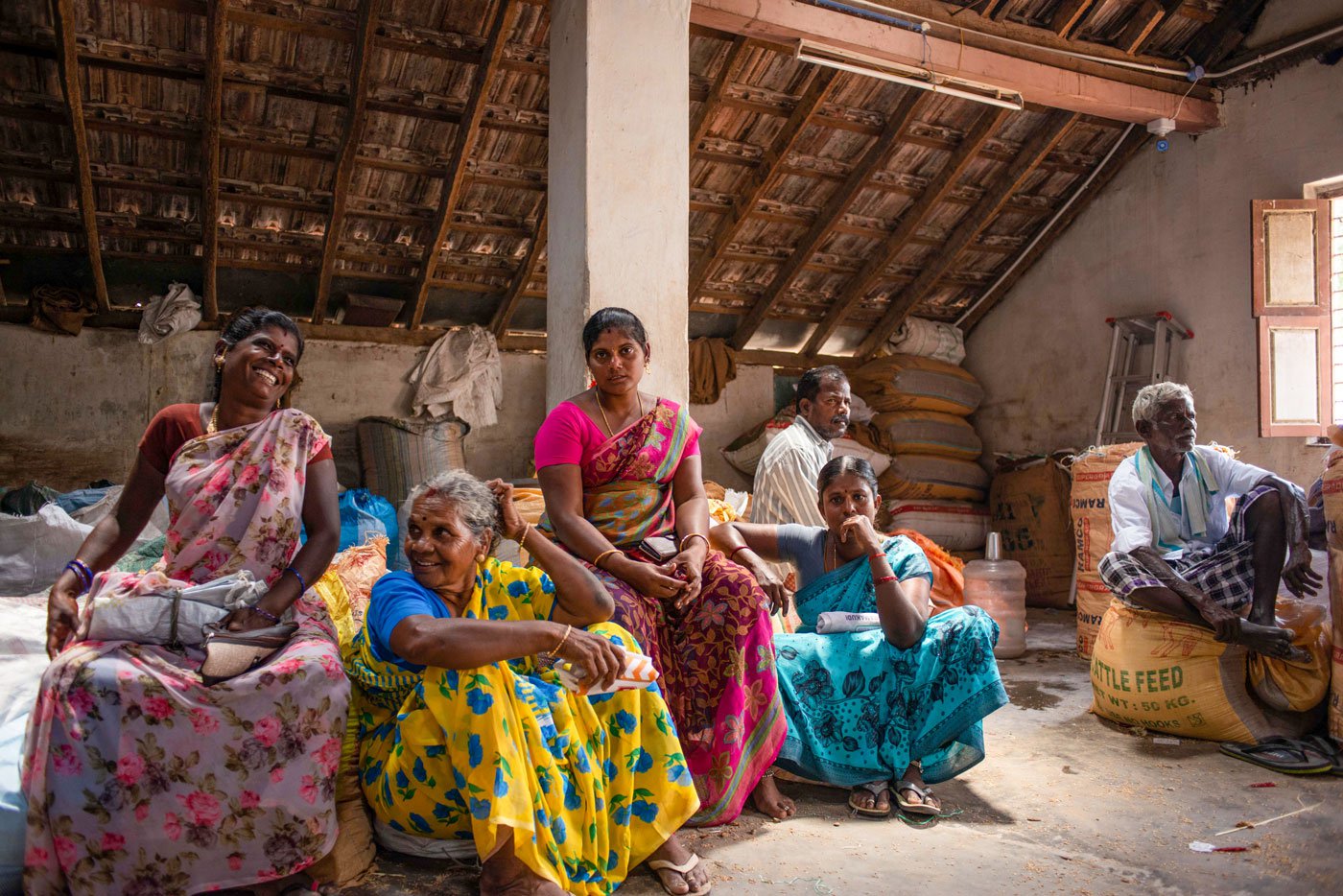
Vasuki (left) and Poomayil in a yellow saree in the centre waiting for the auction with other farmers
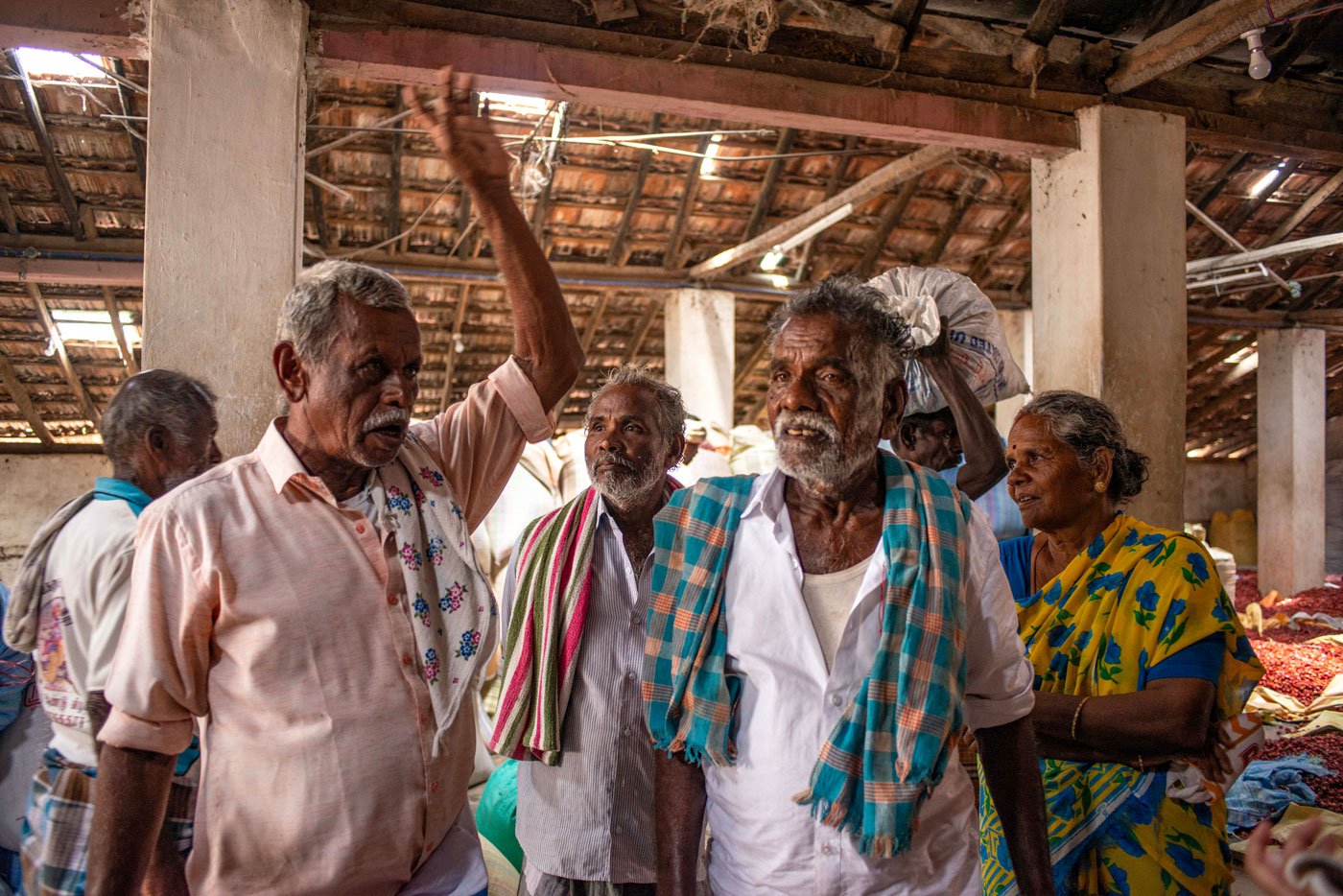
Govindrajan (left) in an animated discussion while waiting for the auctioneer
For 59-year-old P. Poomayil, the 20-kilometre trip from her hamlet – Mummudisathan – is the highlight of the day. She got a free ride that morning. The DMK government, led by Chief Minister M. K. Stalin, had announced a scheme right after coming to power in 2021 that that made travel in town buses free for women .
Poomayil shows me her ticket, and it says magalir (women), and ticket without pay. We discuss her saving – 40 rupees – and a couple of men mutter they too would like to travel free. Everybody laughs, especially the women, happily.
The smiles fade away when Govindarajan lists the reasons for low yield. Mayil, muyal, maadu, maan , he lists in Tamil. Peacock, rabbit, cow, and deer. “And then there is too much rain or too little.” When a good shower would have helped – to increase the flowering and fruiting – there was none. “Earlier, there used to be so much chilli,” he points to the roof, “till there…one man used to stand on top and pour it around, until it became a hill.”
Now the mounds are smaller, and come up to our knees, and they’re varied – some are deep red, some are bright. But they’re all pungent, and every now and then, someone here sneezes, and over there, someone coughs. Coronavirus is still a global threat, but here, inside the trader’s shop, it’s chilli that is the culprit.
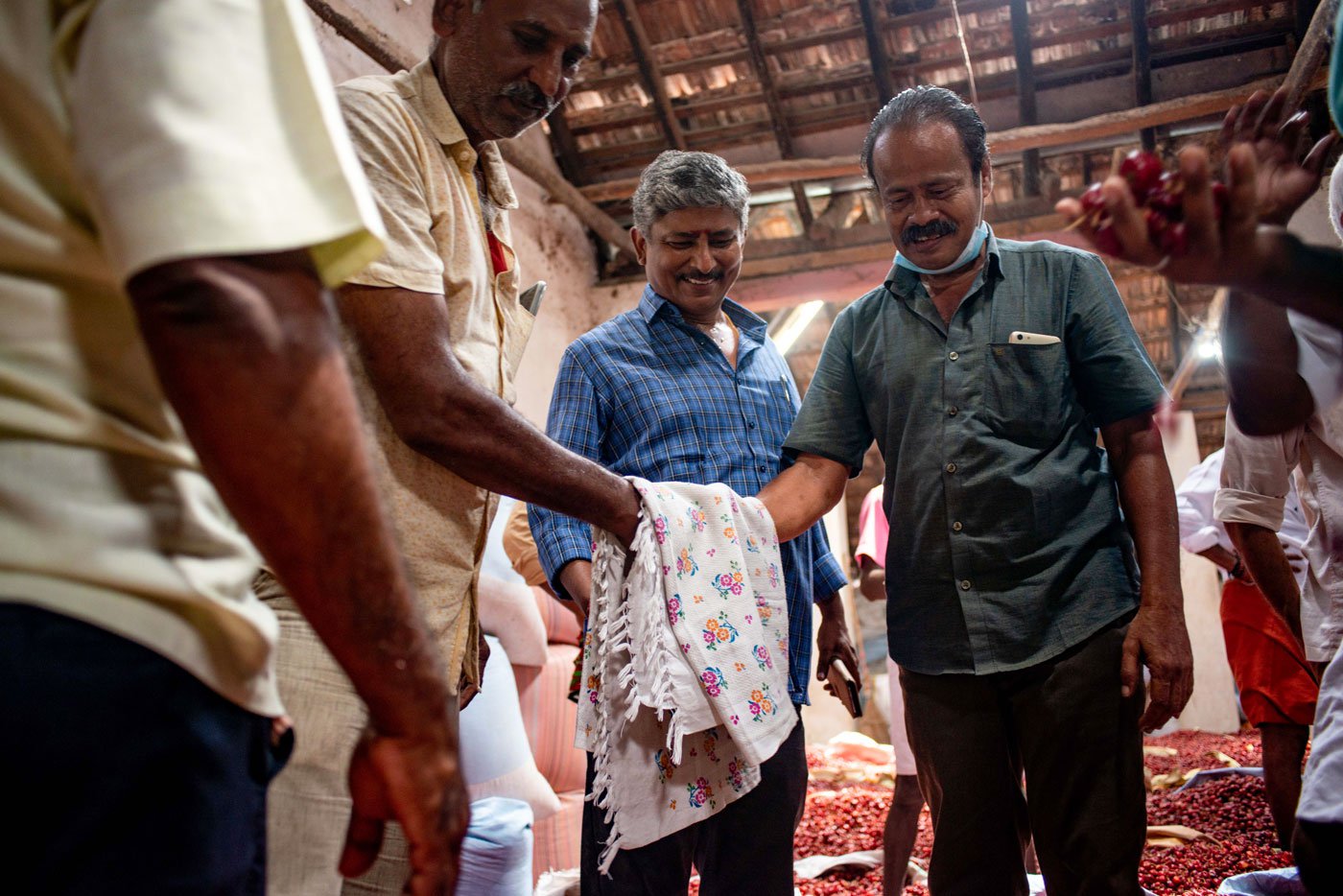
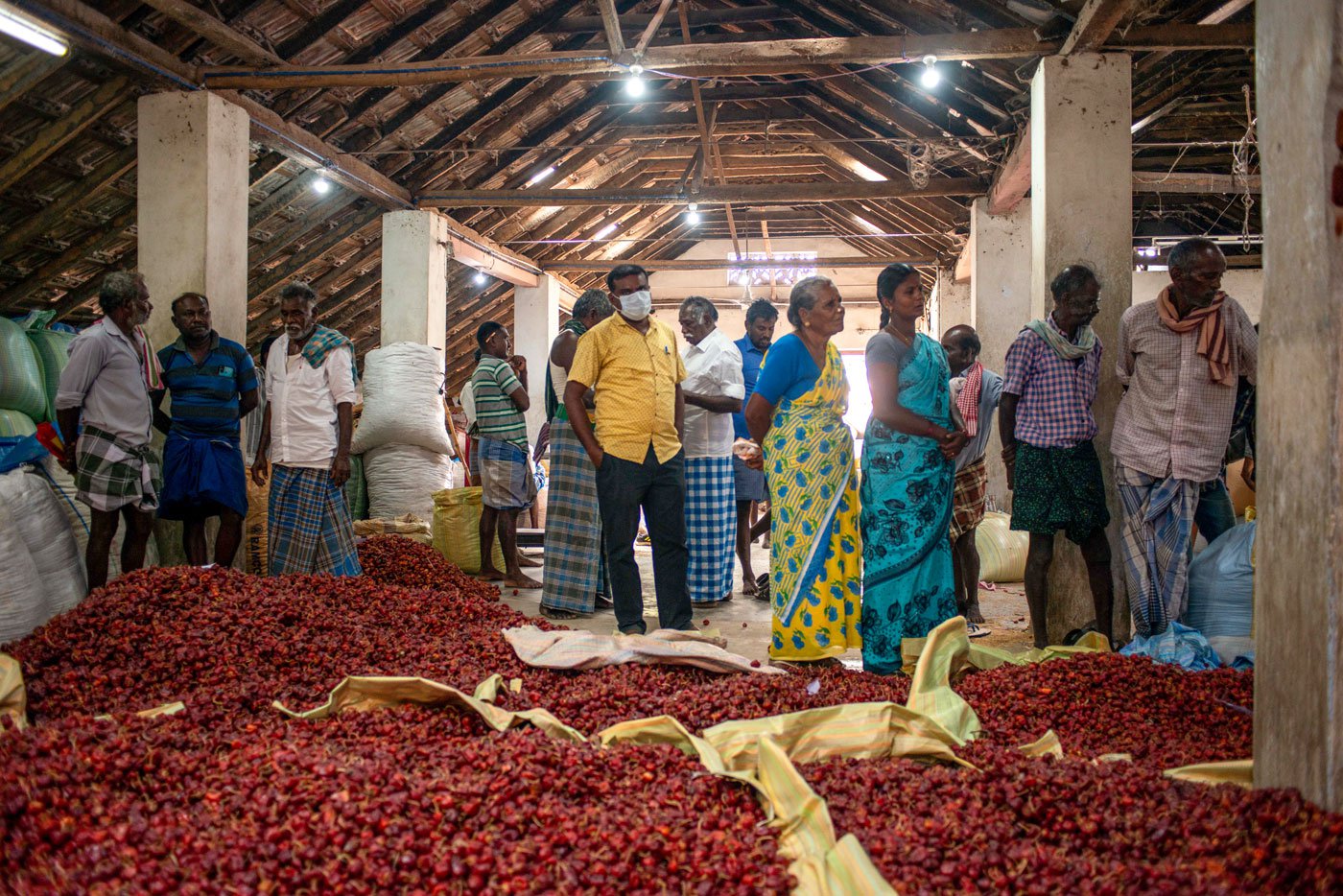
Left: The secret auction that will determine the fate of the farmers. Right: Farmers waiting anxiously to know the price for their lot
By the time the auctioneer, S. Joseph Sengol walks in, everybody’s restless. Instantly, the mood changes. People gather around the chilli mounds, the group that came with Joseph walks over the produce, stands on top of it, and inspects it closely. Then, he drapes a towel over his right hand. Another man – all the buyers are men – clasps his fingers beneath in a secret auction.
This secret language is bewildering for an outsider. But by touching the palm, holding the finger, or stroking one underneath, the men communicate numbers. That is, the price they are quoting for the lot. If they wish to register a ‘no-bid,’ they draw a zero in the middle of the palm. The auctioneer gets a commission for his work – three rupees per bag. And the trader takes 8 per cent of the total sale, from the farmer, for facilitating the auction.
When one buyer’s done, another takes his place opposite the auctioneer, and clasps his fingers under the towel. And another, until everybody has placed their bid, and the highest is announced. That day, red chillies went for 310 to 389 rupees a kilo, depending on the size and colour, which determine the quality.
The farmers are not happy though. A good price, with spectacularly small yields, only assures them of a loss. “We are told to do value addition if we want to earn better,” Govindarajan says. “But tell me, where is the time? Do we grind the chilli and sell the packets, or do we farm?” he asks.
His anger is replaced with tension when his lot comes up for auction. “Come here, you can watch better,” he calls me. “This is like waiting for your exam results,” he says, holding his towel to his mouth, his body tense, keenly observing the secret handshakes. “I got 335 a kilo,” he smiles, when the price is announced. His son’s chilli – slightly bigger fruit – fetched 30 rupees more a kilo. Vasuki’s went for 359 rupees. The farmers relax. But their work is not done. Next, they have to weigh the chilli, collect the money, have a little food, do some shopping and finally, take a bus back home…
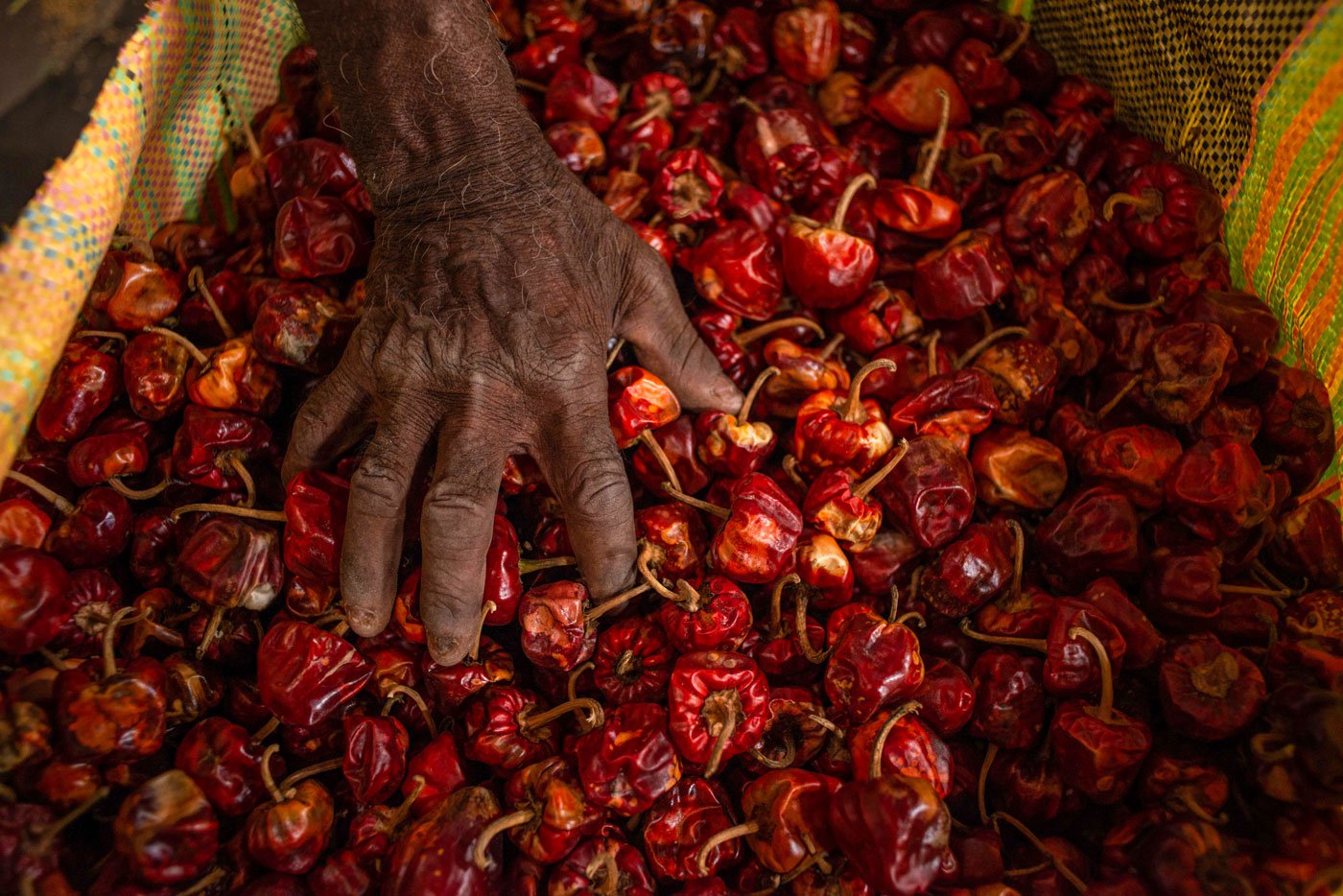
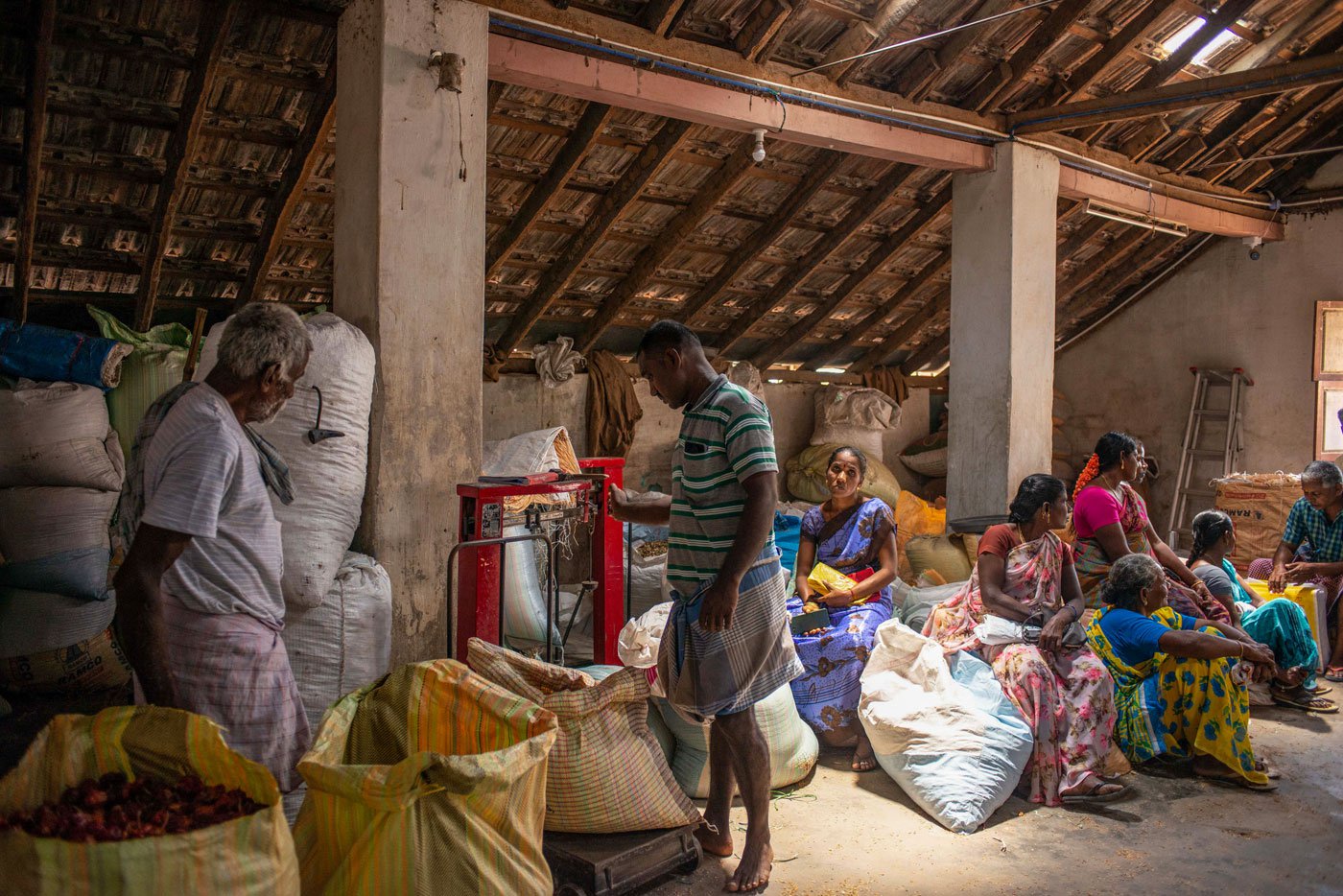
Left: Adding and removing handfuls of chillies while weighing the sacks. Right: Weighing the sacks of chillies after the auction
*****
“We used to go the cinema. But the last film I saw at a theatre was 18 years ago: Thulaatha Manamum Thullum.” (Even a heart that won’t leap, will)
S. Ambika, chilli farmer, Melayakudi, Ramanathapuram
“The field is just a half-hour walk, there’s a short cut” S. Ambika tells us. “But the road takes longer.” Three and a half kilometres and many turns and curves later, we reach her chilli fields in Melayakudi village in Paramakudi block. The plants look lush from a distance: the leaves are emerald green, and each branch is studded with fruit in various stages of ripening: ruby red, turmeric yellow and the beautiful arakku (maroon) of silk sarees. Here and there, orange butterflies flit about, as if the unripe chillies have grown wings.
In ten minutes, the beauty’s lost on us. It’s not quite 10 in the morning, but the sun is sharp, the soil is dry and sweat stings our eyes. Everywhere in the district, we notice fissures on the ground, as if the Ramanathapuram earth is thirsting for rain. Ambika’s chilli plot is no different; the ground is covered in a web of cracks. But she doesn’t think it is that dry. With her toes – the second one circled with silver mettis (rings) – she digs the soil and asks “there, isn’t it moist?”
For many generations, Ambika’s family has farmed for a living. She’s 38, and her sister-in-law S. Rani, who accompanies her, is 33. Their families each own an acre of land. Along with chilli, they grow agathi , a kind of spinach, which makes a great fodder for their goats. Sometimes, they raise ladies-finger and brinjal. And yes, they say, that adds to their work. But don’t they need the income?
The women come to the field every day at 8 a.m. and stay on till 5 p.m. to guard it. “Otherwise goats will eat the plants!” Every morning, they’re up at 4, cleaning the house, collecting water, cooking, waking up the kids, washing vessels, packing food, feeding the livestock and poultry, walking to the field, working, sometimes going back home in the afternoon to give water to the animals. Then, back to the chilli plants, tending to them, and another half-hour walk through the ‘short cut,’ where now a dog is chased by her pups. At least that mother could run away for a bit…
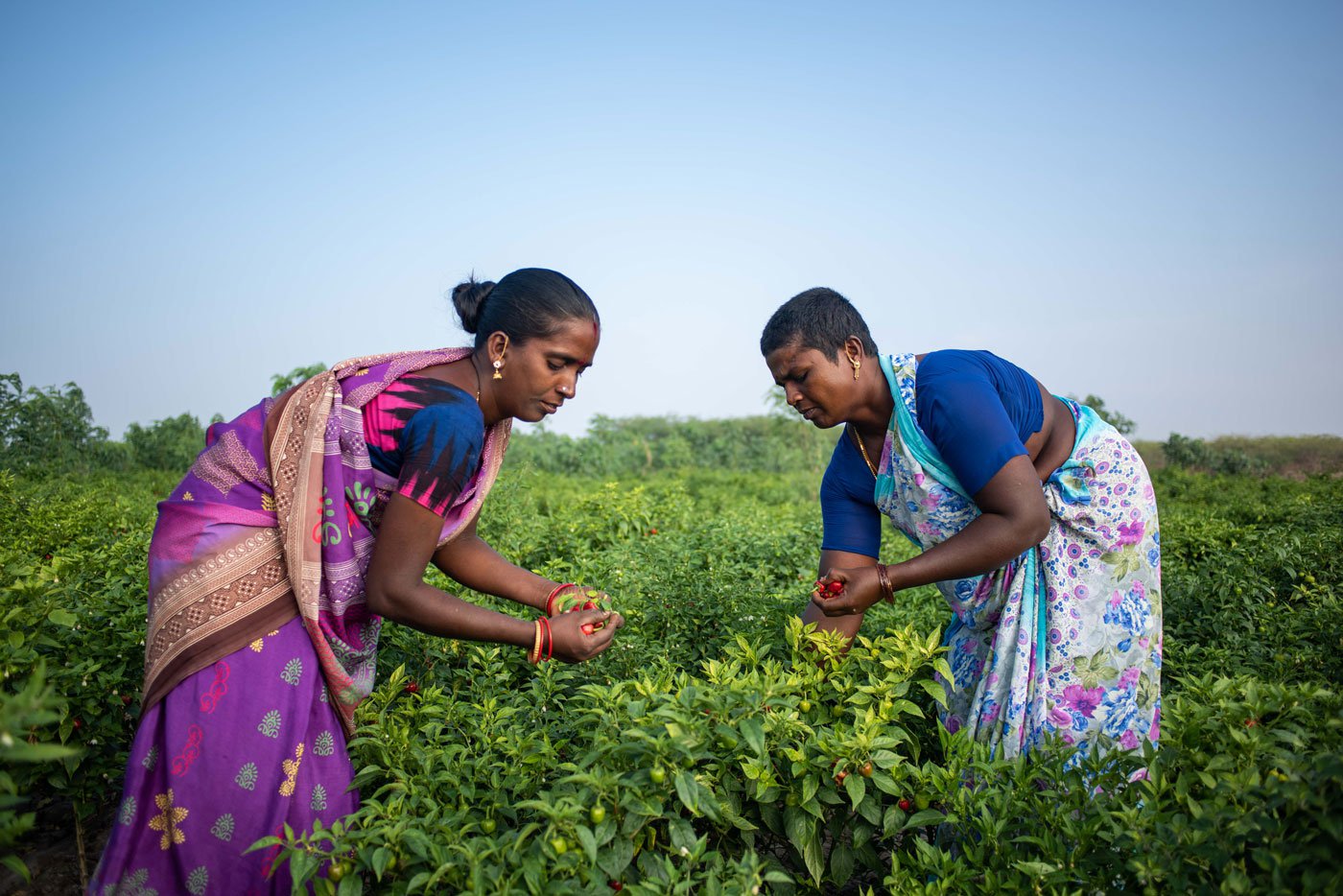
Ambika wearing a purple saree working with Rani in their chilli fields
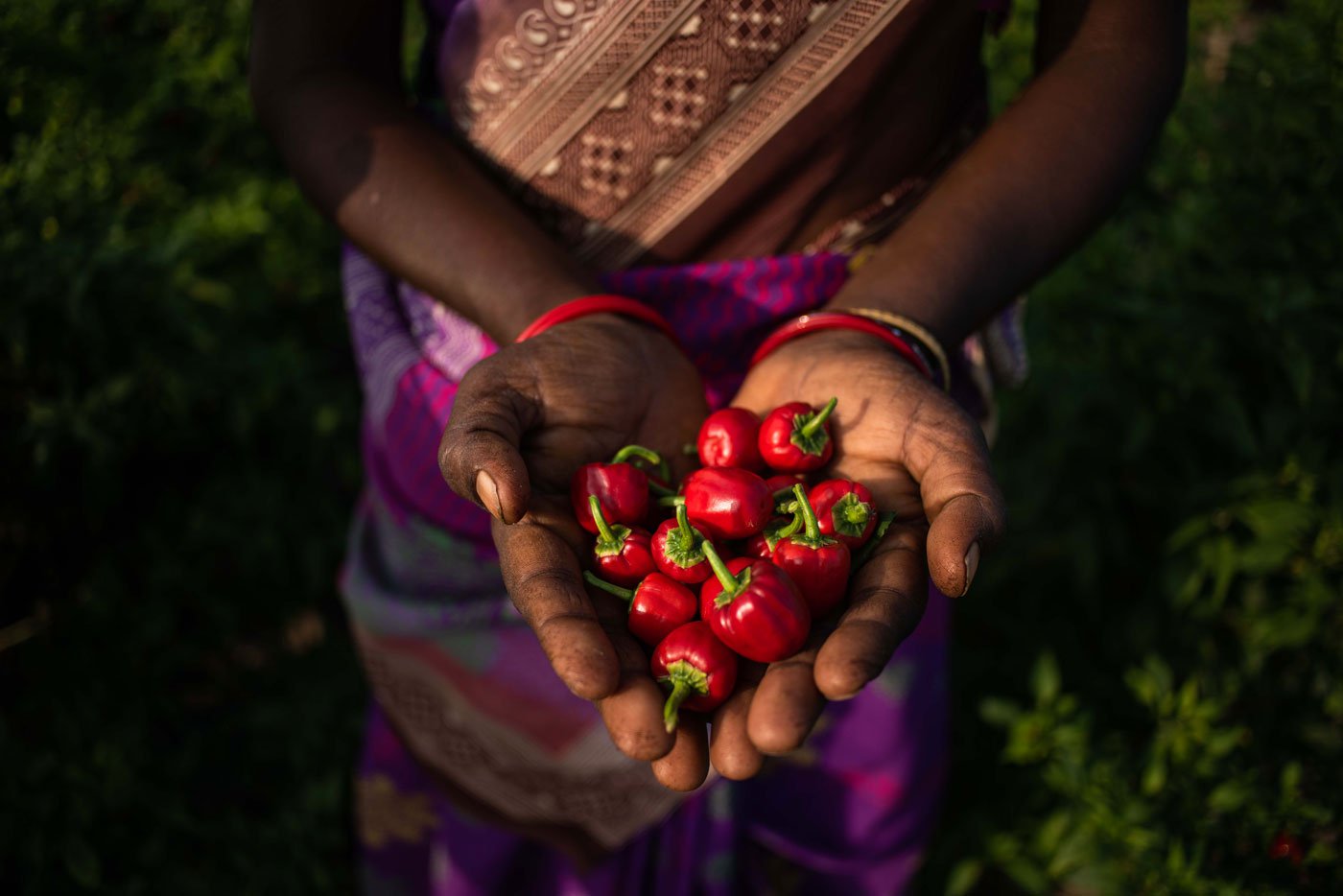
Ambika with some freshly plucked chillies
Ambika’s son rings her. “ Ennada ,” she snaps when the phone sings the third time, “what do you want?” She frowns as she listens to him and hangs up after gently scolding him. The children are also demanding at home, the women tell me. “No matter what we cook, they ask for eggs and potatoes. So we fry a little of this and that. On Sundays, we buy whatever meat they want.”
As we speak, the women – and those in the neighbouring fields – are plucking chillies. They are quick, lifting the branches delicately, snapping the chillies off them. Once they have a handful, they drop them into a paint bucket. Earlier, they used palm leaf baskets, Ambika says. But now it is plastic, sturdy pails that last many seasons.
Back home on Ambika’s terrace, her harvest lies under a fiery sun. Carefully, she spreads the red chillies and turns them around often, so that they dry evenly. She grabs a few and shakes them. “When it is ready, it will make a gada-gada sound.” That’s the seeds rattling inside the fruit. At that stage, they gather and weigh the chillies in sacks, and take them to the commission agent in the village. Or to the market in Paramakudi or Ramanathapuram, to get a slightly better price.
“Would you like a colour (bottled drink),” Ambika asks me, downstairs, in her kitchen.
She takes me to see the goats penned in a field nearby. The farmer’s guard dogs – sleeping under wire cots – wake up and warn us not to come close. “My dog also guards me when my husband goes away to serve food in functions. Otherwise, he is also a farmer, and labourer, when he finds work.”
She blushes when she talks of her early married days. “We used to go the cinema then. But the last film I saw at a theatre was 18 years ago: Thulaatha Manamum Thullum .” Something about the title – ‘Even a heart that won’t leap, will’ – makes both of us smile.
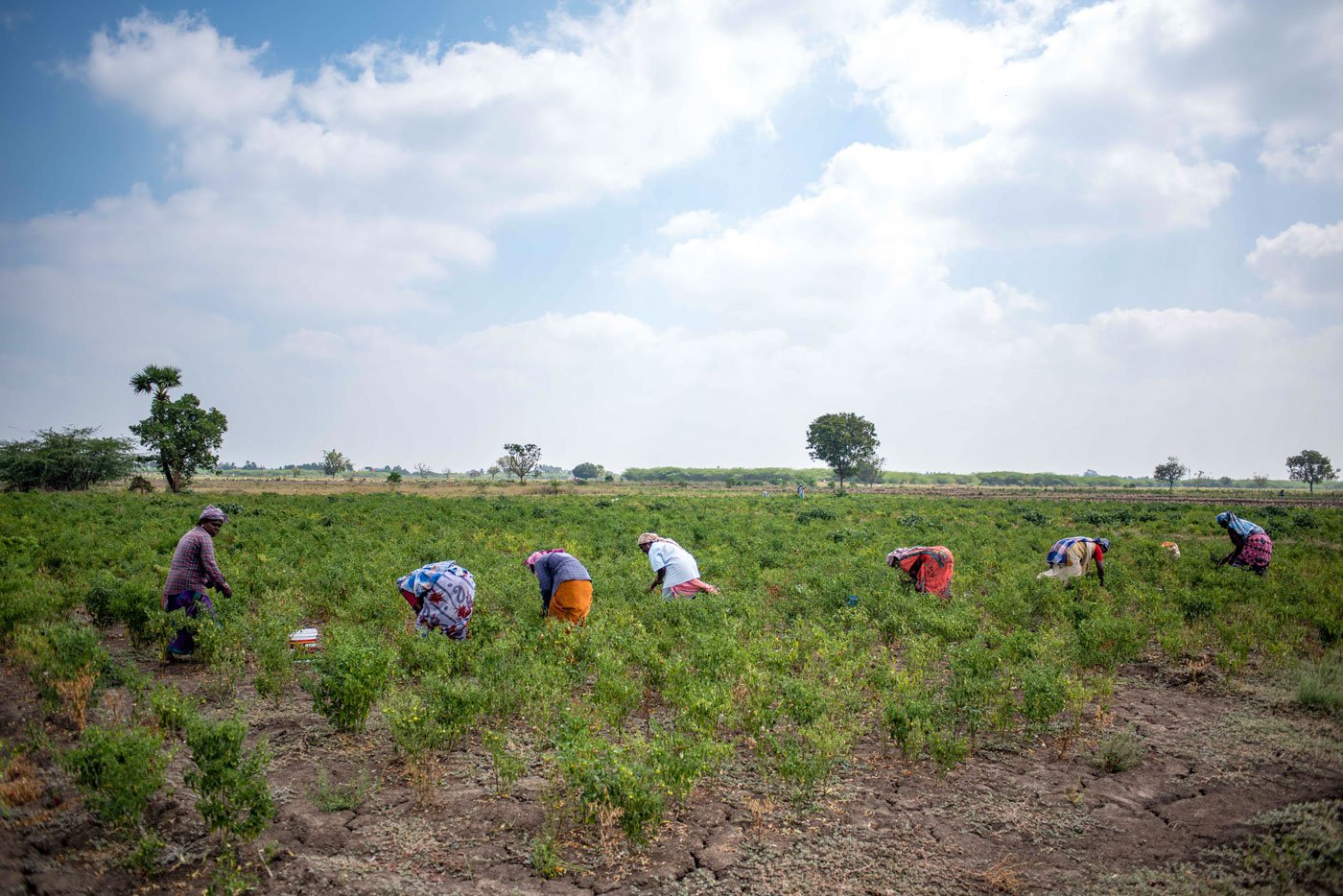
Women working in the chilli fields
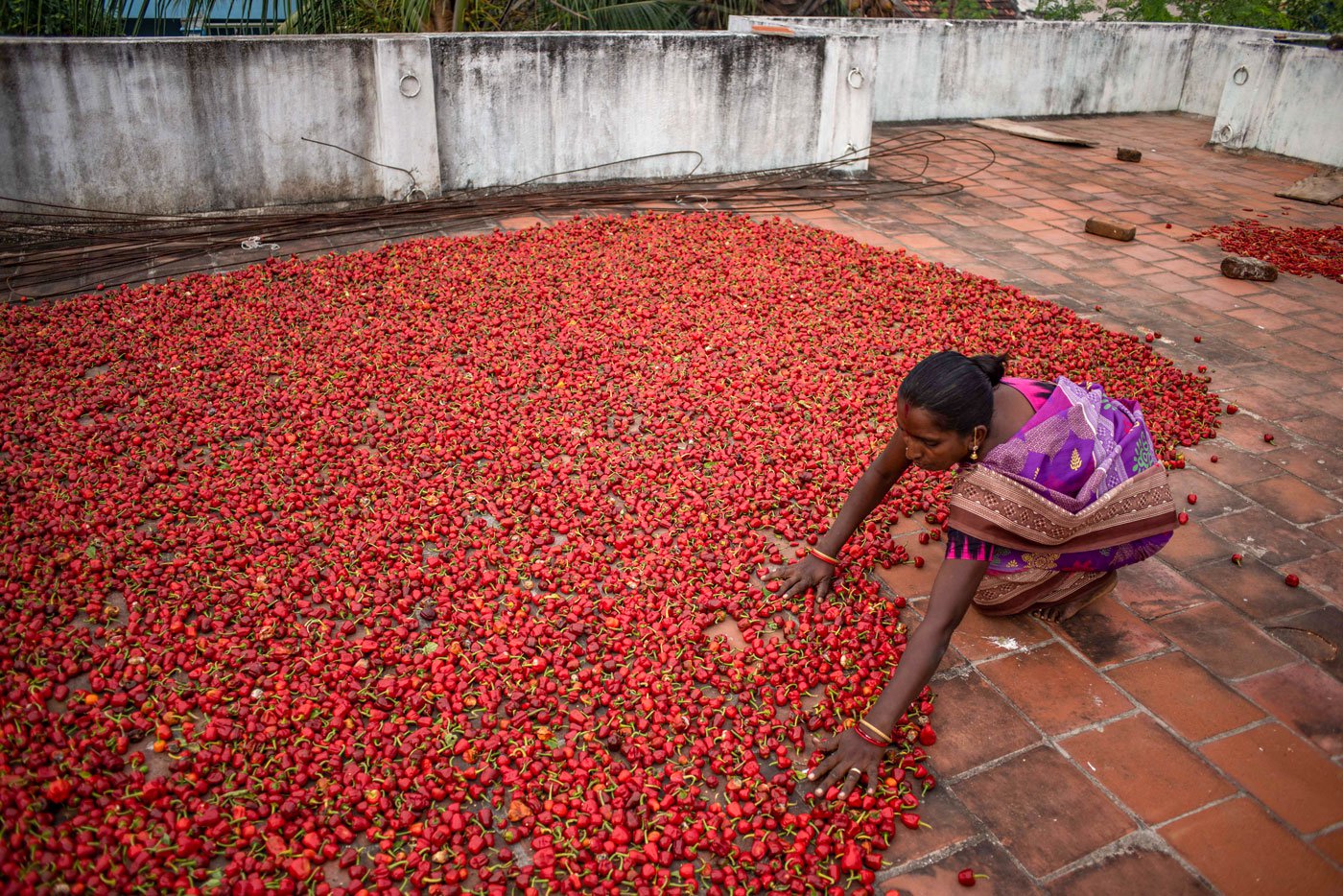
Ambika of Melayakudi village drying her chilli harvest on her terrace
*****
“Small farmers lose 18 per cent of income trying to sell their chilli harvest”
K. Gandhirasu, Director, Mundu Chilli Growers’ Association, Ramanathapuram
“Take farmers – who have five or ten sacks of chilli. First, you have to pay for the tempo/ other transport from your village to the mandi,” says Gandhirasu. “There, traders will come and fix the price and take eight per cent as commission charges. Third, there might be a discrepancy in weight, usually to the trader’s advantage. If they reduce even half a kilo per bag, it is a loss. So many farmers complain about this.
Further, one person has to spend the whole day at the market without attending to the farm. If the trader has money, they will pay immediately. If not, they will ask them to come again. And lastly, if it a man who goes to the market, he is unlikely to carry lunch. He will eat in a hotel. We calculated everything and found all this takes away 18 per cent of their income.”
Gandhirasu runs a farmer producer organization (FPO). Since 2015, Ramnad Mundu Chilli Production Company Limited, has worked towards increasing farmers’ income. He’s the Chairman and Director, and he meets us in his office in Mudukulathur town. “How do you increase the income? First, you reduce the cost of cultivation. Second, you increase production. And third, provide marketing interventions. Right now, we’re focusing on the marketing.” In Ramanathapuram district, he found an urgent need for intervention. “Migration is so high here,” he points out.
Government figures back his statement. Tamil Nadu Rural Transformation Project’s diagnostic report for Ramanathapuram district estimates between 3000 and 5000 farmers migrating every year. It also notes the influence of middle-men, poor water resources, droughts, and lack of cold storage as hurdles to productivity.
Water is the game changer, says Gandhirasu. “Go to the agricultural fields in the Cauvery Delta region or Western Tamil Nadu. What do you see?” He pauses for effect. “Electricity poles. Because there are borewells everywhere.” In Ramanathapuram there are far fewer, he says. Rain-fed irrigation has its limitations, subject to the vagaries of the weather.
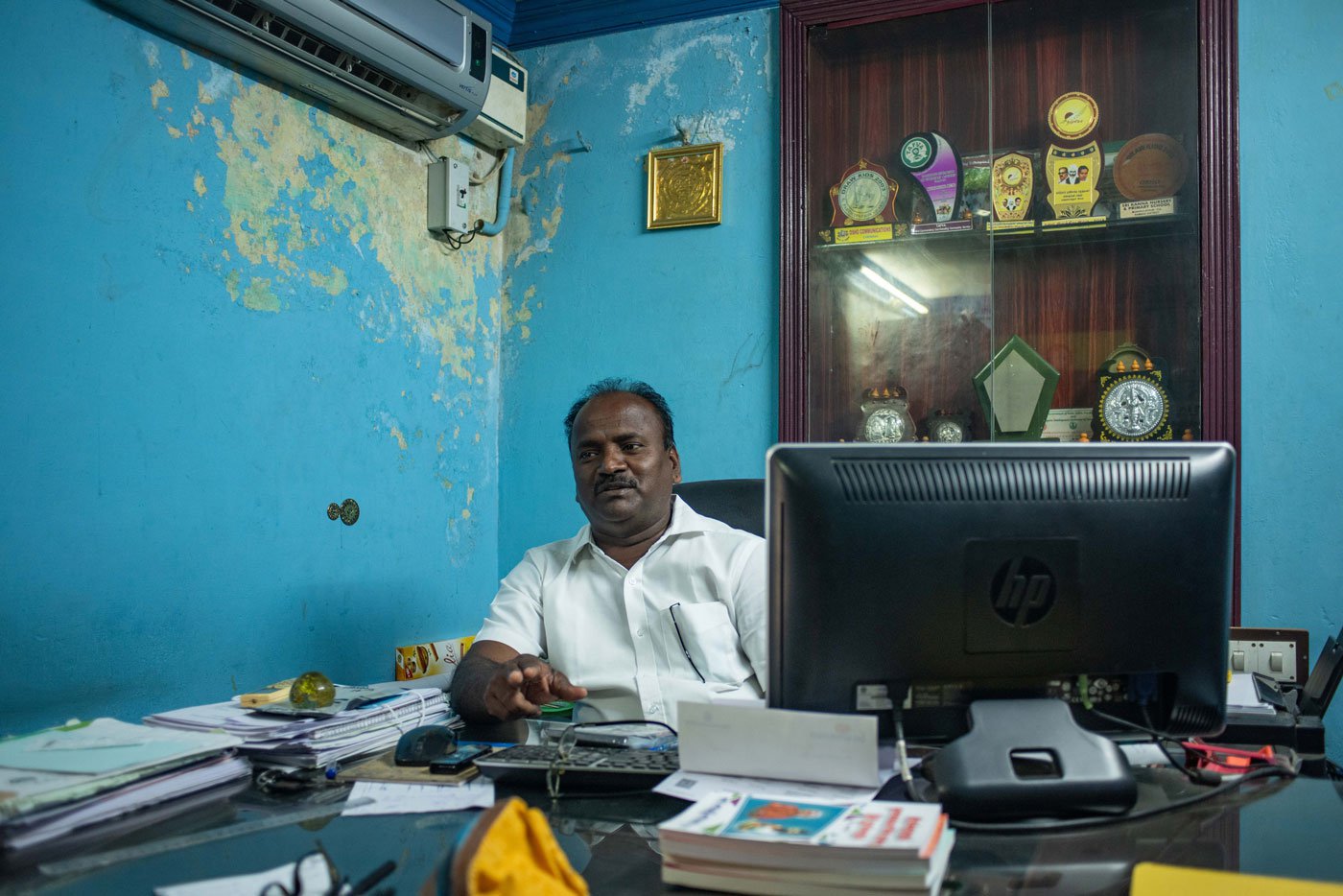
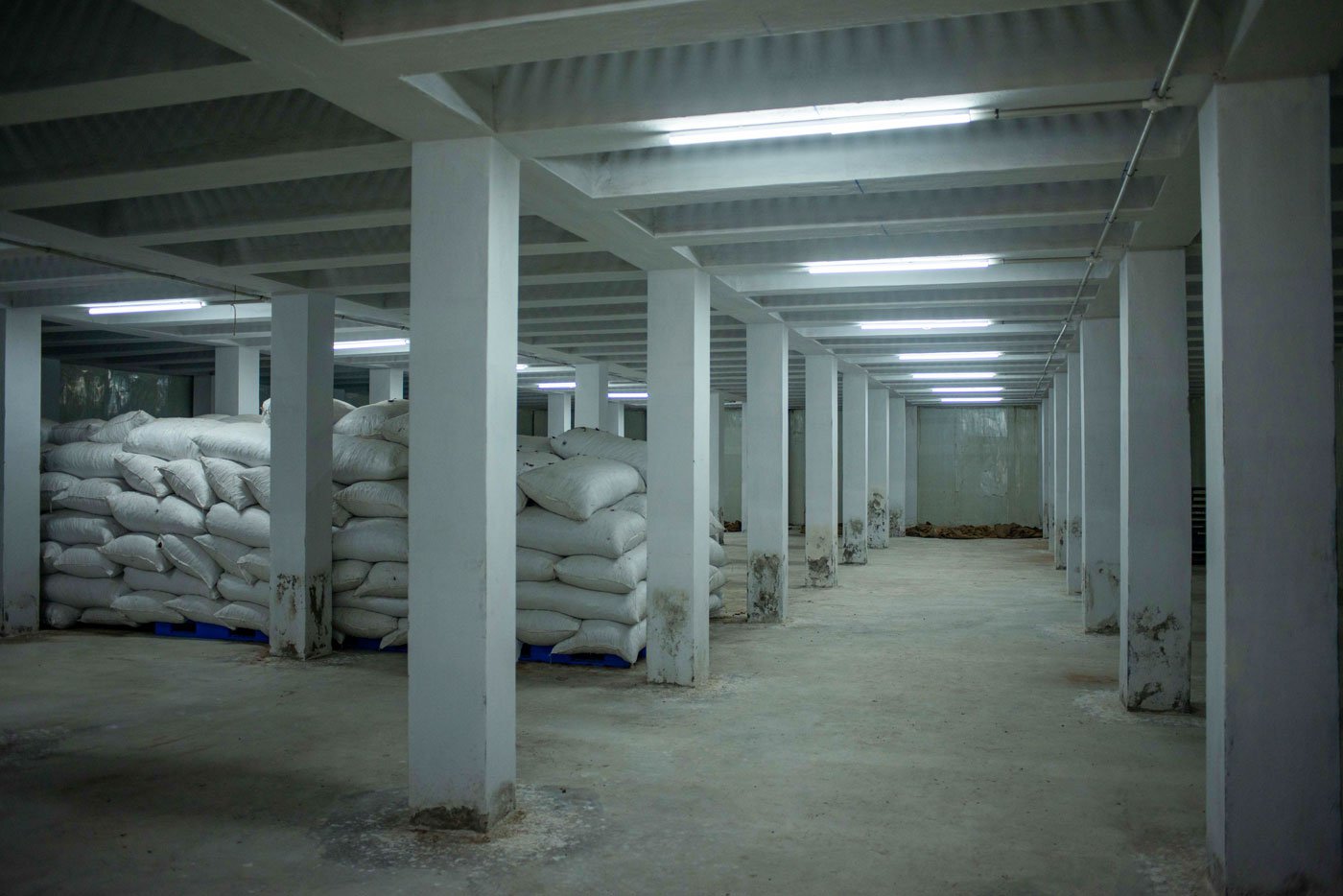
Left: Gandhirasu, Director, Mundu Chilli Growers Association, Ramanathapuram. Right: Sacks of red chillies in the government run cold storage yard
Once again, government data - this time from the district statistical handbook - bear out his statement. The district had just 9,248 pumpsets in 2018-19, according to data from the Ramanathapuram electricity distribution circle. This is a tiny fraction of the 18 lakhs pumpsets in the state.
Ramanathapuram’s problems however are hardly new. In Everybody Loves a Good Drought (published: 1996) journalist P. Sainath interviewed the celebrated writer (late) Melanmai Ponnuswamy. “Contrary to common belief, this district does have good agricultural potential. But who has ever worked with that view in mind?” He went on to add that “more than 80 per cent of the landholdings in Ramnad are less than two acres in size and uneconomical for many reasons. At the top of the list is a lack of irrigation.”
Ponnuswamy was spot on about the potential. In 2018-19, Ramanathapuram district traded in chillies worth 4,426.64 metric tonnes valued at Rs. 33.6 crores. (Paddy which cornered much of the irrigated land, yielded only Rs. 15.8 crores).
The son of a farmer himself – and having practiced agriculture even while doing his master’s degree, – Gandhirasu recognises chilli’s promise. He quickly dives into the economics of farming it. Typically, a small farmer raises this crop in an acre of land. During the harvest, they hire some labour, and the family usually handles the rest themselves. “It costs between 25,000 rupees to 28,000 rupees to cultivate mundu chilli in an acre. Harvest costs add another 20,000 rupees. That is, for 10 to 15 people who do four rounds of plucking.” Each labourer can gather a sack of chilli a day. When the plants are dense, it is harder work, he points out.
Chilli is a six-month crop. It is sown in October, and there are two bogams (yields): the first fruiting is in Thai , the Tamil month starting from mid-January. The second ends in Chithirai (beginning mid-April). In 2022, unseasonal rainfall disrupted the whole cycle. The first batch of seedlings died, flowering was delayed, and fruiting was poor.
And because of poor supply and good demand, the price has been better than in most years. Farmers at Ramanathapuram and Paramakudi markets were talking about the extraordinary prices that chilli fetched in the early days of March, when the first bags appeared – 450 rupees a kilo. There were whispers of it reaching the 500-rupee figure.
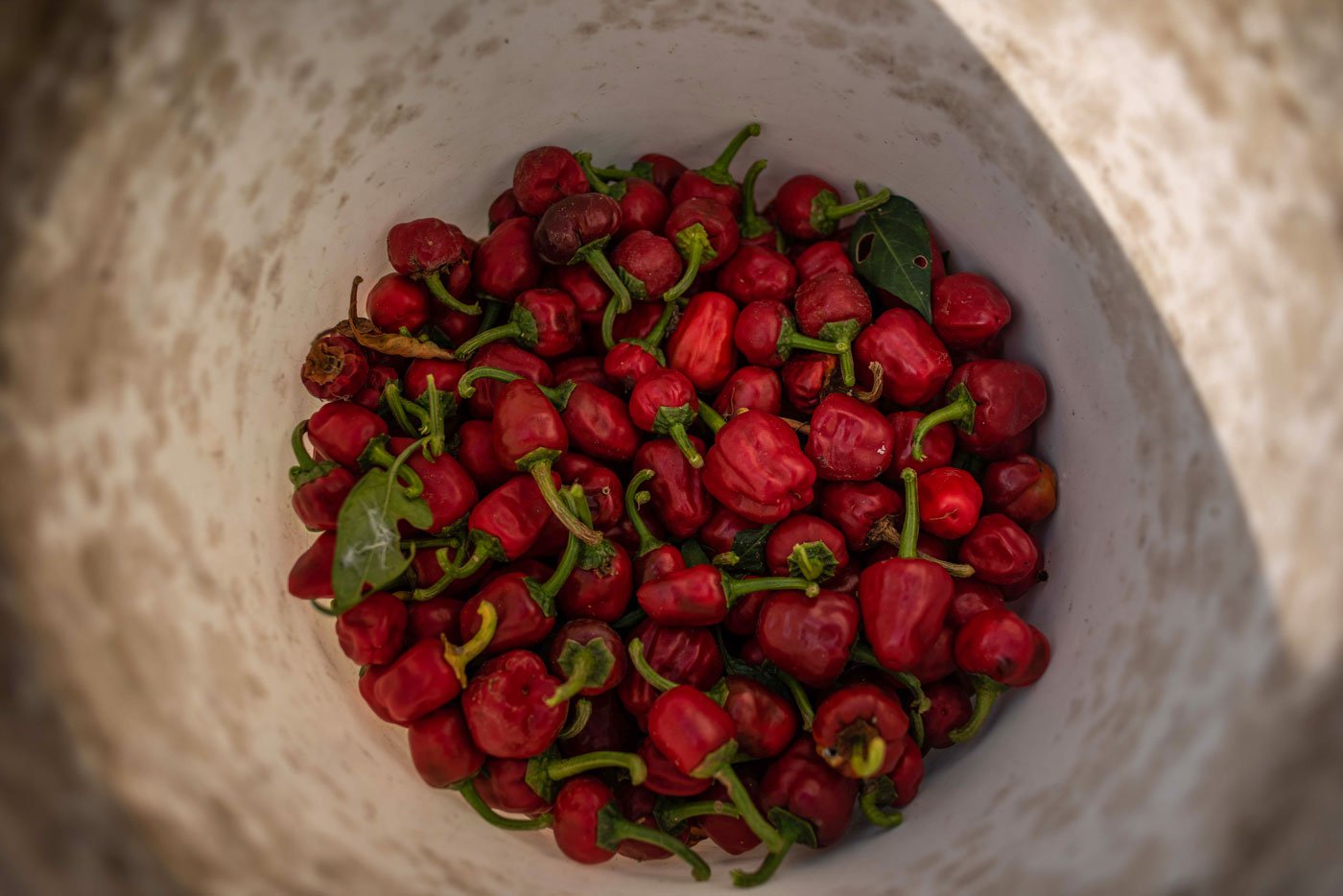
Ambika plucks chillies and drops them in a paint bucket. Ramnad mundu, also known as sambhar chilli in Chennai, when ground makes puli kozhambu (a tangy tamarind gravy) thick and tasty
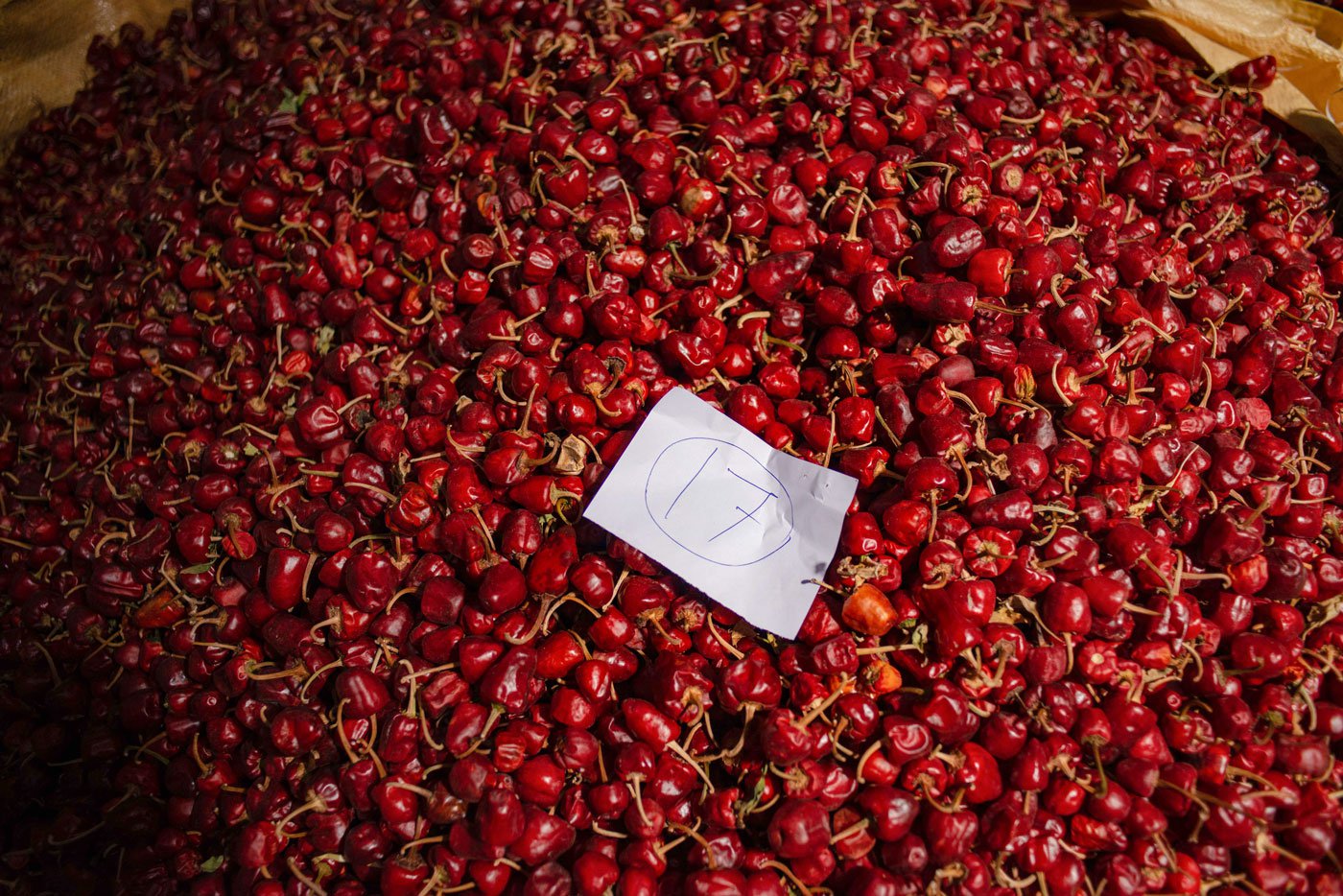
A lot of mundu chillies in the trader shop. The cultivation of chilli is hard because of high production costs, expensive harvesting and intensive labour
Gandhirasu calls those numbers a ‘tsunami.’ He pegs the breakeven price for a kilo of mundu chilli at 120 rupees a kilo. With a yield of 1,000 kilos in an acre, a farmer can see a profit of about 50,000 rupees. “Two years ago, chilli only fetched 90 or 100 rupees a kilo. Today’s rate is very good. But we can’t bank on a price of 350 per kilo. This is an aberration.”
Mundu chilli is a popular crop in the district, he points out. It is a ‘peculiar’ variety, he says, describing the miniature tomato look perfectly. “Ramnad mundu is called sambhar chilli in Chennai. Because the skin is also thick, it makes for a thick puli kozhambu (a tangy tamarind gravy) if you grind it in. And the taste will be fantastic.”
There is a huge market for mundu in India and abroad. And online, as a quick search revealed. By mid-May, mundu chilli was selling for a fabulous 799 rupees a kilo on Amazon. This price was after an attractive 20 per cent discount.
“We don’t know how to lobby for this,” admits Gandhirasu. “Marketing is a problem.” Besides, not all the members of the FPO – over 1,000 farmers – sell their produce to their organisation. “We can’t generate that kind of funds to buy all their harvests, nor can we store it.”
Keeping the crop – especially if the FPO wishes to wait for better prices – is made harder because chillies turn black when kept for many months and the powder can be infected with pests. At the government-run cold storage facility – about 15 kilometres from Ramanathapuram town – we had walked around the refrigerated yards where sacks of chillies were stored the previous year. While the administration was trying to bring both traders and producers to the same location, farmers were hesitant. They were unsure of the feasibility of transporting their produce to and from the facility.
For its part, the FPO is advising farmers to try traditional methods of pest control. “In this region, aamanakku (castor) was usually grown around the chilli fields, since it draws any pests that come to attack milagai . Plus, castor is a big plant which attracts small birds. They too will eat the pests. It is like an uyirvelli , a living fence.”
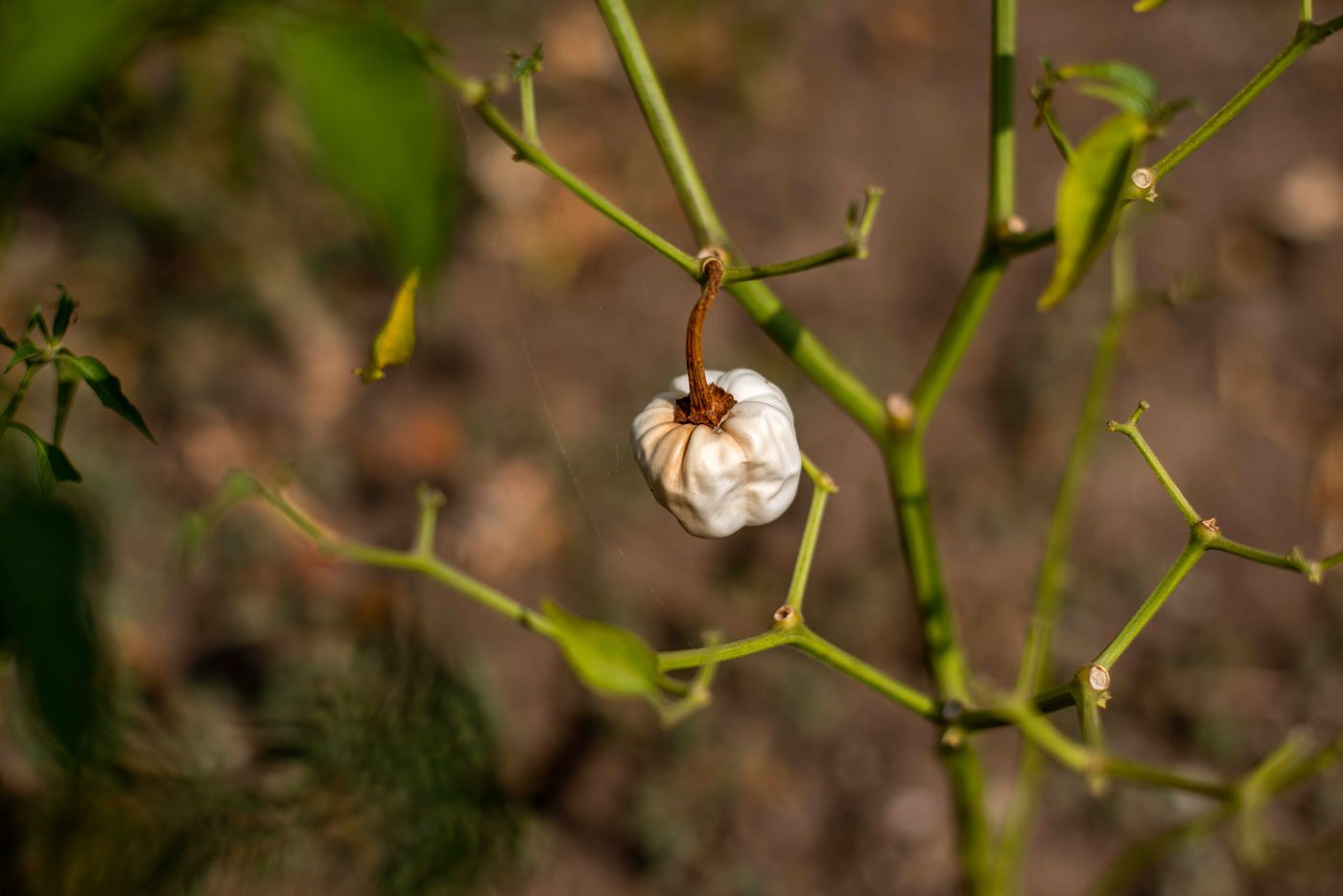
Changing rain patterns affect the harvest. Damaged chillies turn white and fall down
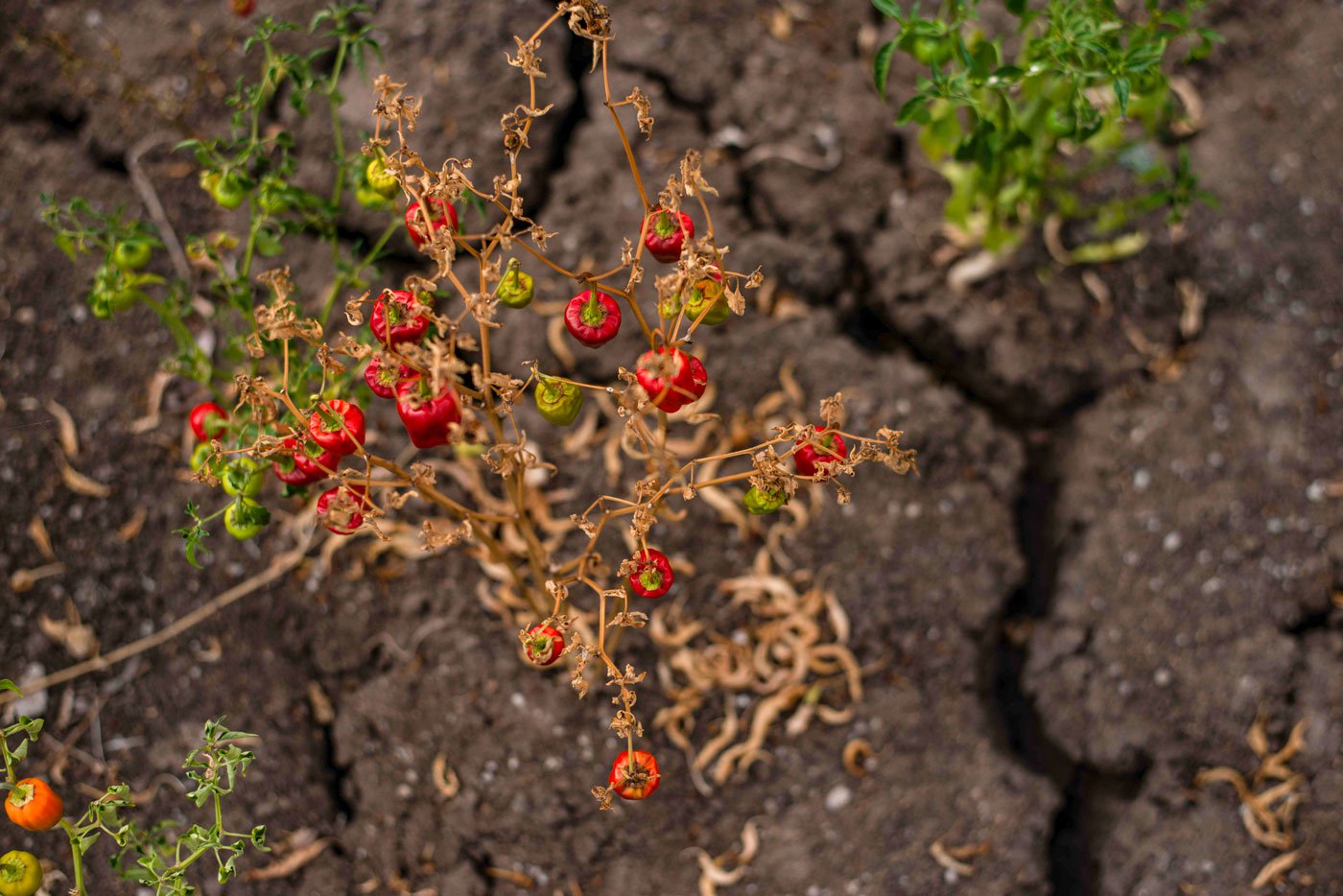
A dried up chilli plant and the cracked earth of Ramanathapuram
He recalls his mother planting aamanakku and agathi (a popular spinach variety called August Tree) on the boundaries. “When she used to go to tend the chillies, our goats would run behind her. She would tie them to one side and feed them agathi and aamanukku leaves. That wasn’t all. If milagai was a major crop, aamanakku was a minor one. My father would get the money from the chilli harvest. My mother would keep the money that came from castor.”
Besides lessons from the past, Gandhirasu is looking to the future – and science – for help. “We need a chilli research centre in Ramanathapuram, especially in Mudukulathur,” he says. “Paddy, banana, cardamom, turmeric – all have research centres. Only if you have a school and college, you will send your kids to get educated. Only if there is a centre, you will address the problems and find solutions. Then, chillies will go to the ‘next level’.”
Right now, the FP is working on a Geographical Indication tag for the mundu variety. “This chilli’s special characteristics have to be spoken about. Maybe we need a book about it?”
The much-touted solution for all agri-problems – value addition – might not work for chilli, Gandhirasu says. “Look, each person has 50 or 60 sacks of chilli. What can they do with that? Even the FPO collectively cannot compete with masala companies and sell chilli powder cheaper than them. Plus, their marketing budget runs to crores.”
But the main problem in the future, Gandhirasu says, will be climate change.
“What are we doing to tackle that?” he asks. “Three days ago, there was a storm threat. I have never heard of it in March! Chilli plants will die if there is too much water. Farmers have to find ways to adapt.”
*****
Women borrow as much – or as little – as they need. Education, marriage, delivery – we will never say no to loans for these. Even agriculture comes after that.”
J. Adaikalaselvi, chilli farmer and SHG leader P. Muthuvijayapuram, Ramanathapuram
“You’re scared you’ll pull out the plant, isn’t it?” Adaikalaselvi laughs. She’s put me to work on her neighbour’s field. He had remarked that he was short staffed and was praying for some extra help. He quickly regrets giving thanks – because he finds out I’m hopeless. Adaikalaselvi meanwhile has grabbed a bucket and is plucking chillies off her third plant. I sit next to my first one and pull a fat chilli. The stem is thick and tough – nothing like the brittle one of the dried red chillies in my anjalapetti (masala box), back home – and I’m worried I’ll break the branch.
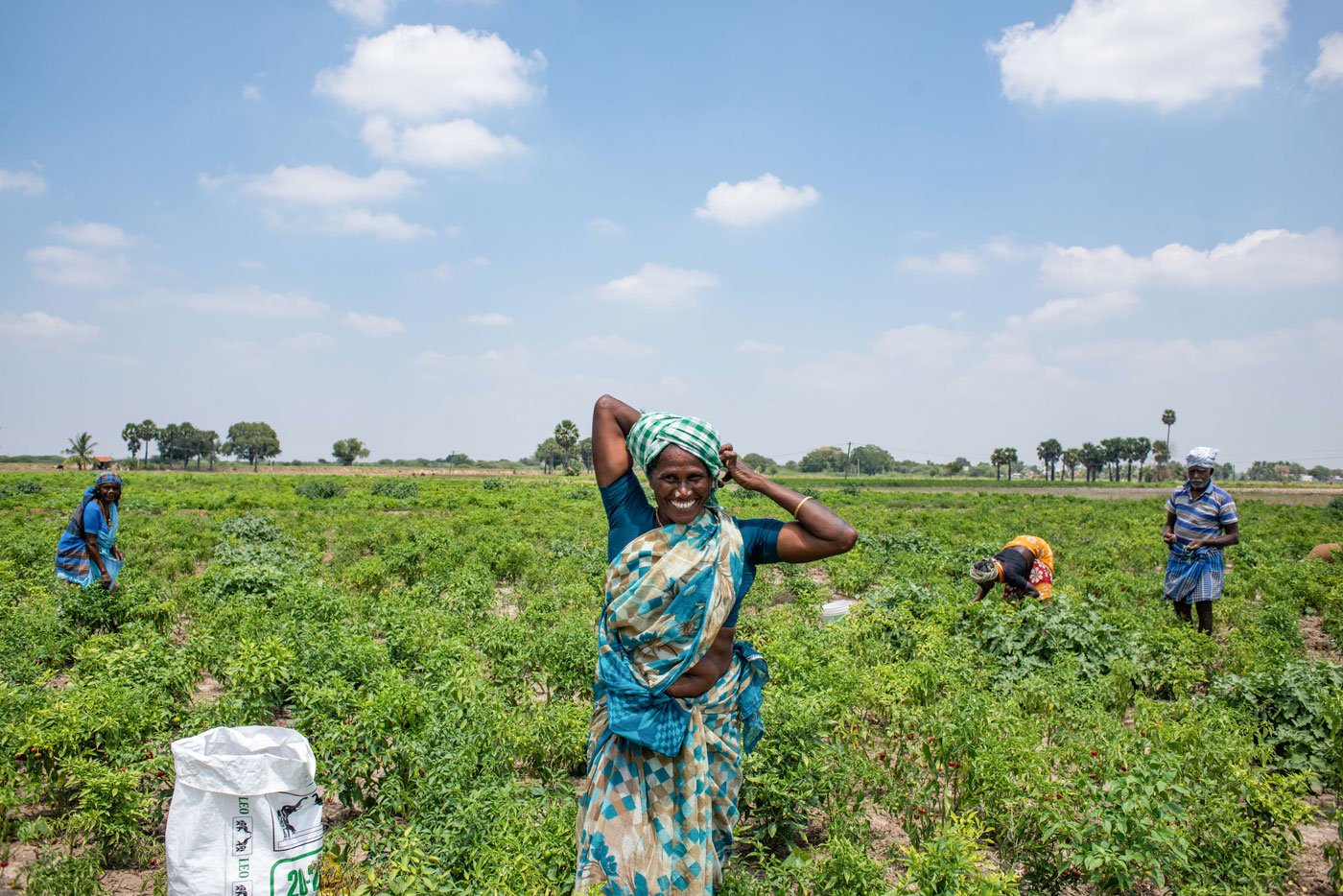
Adaikalaselvi adjusting her head towel and working in her chilli field
A few women gather around to watch. The neighbour shakes his head. Adaikalaselvi makes encouraging noises. Her bucket is filling up, my palm has about eight red fruits. “You should take Selvi with you to Chennai,” the neighbour says. “She can handle the field, she can also handle an office.” He offers me no job. It’s clear I flunked.
Adaikalaselvi does handle an office in her house. It’s set up by the FPO and includes a computer and xerox machine. Her job is to make photocopies of documents and help people find information about pattas (land title deeds). “I won’t have time to do anything more. There are goats and poultry too, to care for.”
Her responsibilities also include running the magalir mandram or women’s self-help group. There are sixty members in the village, split into five groups and each has two thalaivis (leaders). Adaikalaselvi is one of the ten. Among their activities, the leaders collect and disburse money. “People take out loans at such high interest – rendu vatti, anju vatti (24 to 60 per cent per annum). Our magalir mandram loans are oru vatti – 1,000 rupees for every lakh.” That’s around 12 per cent per annum. “But we don’t give the whole amount we collect to just one person. Everybody here is a small farmer, they all need some money to tide over, isn’t it?”
Women borrow as much – or as little – as they need. And mostly with three priorities in mind, she explains. “Education, marriage, delivery – we will never say no to loans for these. Even agriculture comes after that.”
Adaikalaselvi also brought about an important change – in the repayment of loans. “Earlier, it used to be that you had to pay a fixed amount every month. I told them: we are all farmers. We will have no money some months, and after we sell a harvest, we’ll have some cash. Let people pay when they can. Everybody should benefit from this, isn’t it?” It’s a lesson in inclusive banking practices. One that accounts for local and lived realities.
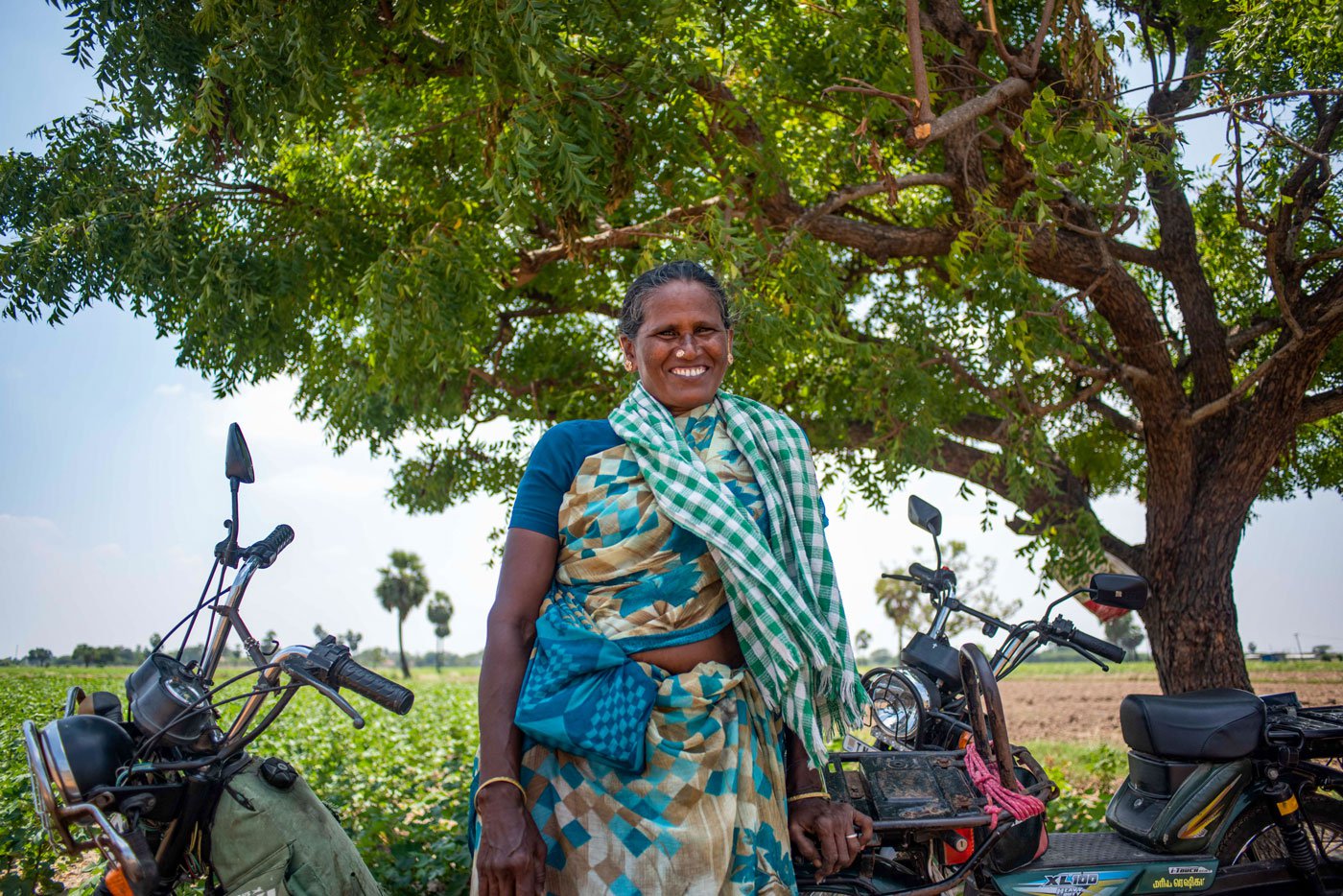
Adaikalaselvi, is among the ten women leaders running women’s self-help groups. She is bringing about changes in loan repayment patterns that benefit women
The magalir mandram – which existed in the village even before her marriage, 30 years ago – also organizes programmes for the village. The weekend after our visit in March, they planned to celebrate women’s day. “After Sunday mass at the church, we will be handing out cakes,” she smiles. They also conduct prayers for rain, make a Pongal, and serve everybody.
Because she’s bold and speaks freely, Adaikalaselvi advises men in the village, if they have a tendency to drink or abuse their wife. She is also an inspiration for other women, driving her bike, and looking after her fields by herself for decades. “Younger women are all smart, they drive bikes, they are well educated. But,” she asks sharply, “where are the jobs?”
Now that her husband is back, he helps with the farm. And she uses the freed-up time to do other stuff. Like that relating to cotton, which she also grows. “For the last ten years, I have been removing cotton seed and selling it separately. That goes for 100 rupees a kilogram. Many people buy it from me – because my seeds sprout very well. Last year I think I sold 150 kilos of seeds.” She opens a plastic bag, and like a magician and his rabbit, pulls out three covers and shows me different grades of seeds. It’s another hat that she wears with little fuss – that of a seed saver.
By late May, her chilli harvest is done, and we speak on the phone about the season. “The price fell from a high of over 300 to 120 rupees a kilo. It dropped steadily,” she tells me. She only got 200 kilos of chillies from an acre. And paid 8 per cent commission on the sale, plus lost out 1 kilo for every 20, because the traders discounted an extra 800 grams on the 200 gram sack. She broke even this year because the price wasn’t too bad. But the rain, she says, messed with the plants, and shrunk the yield.
Nothing, however, shrinks the work of a farmer. Even a poor chilli crop has to be plucked, and dried and bagged and sold. And Adaikalaselvi and her friends’ labour adds taste to every spoonful of sambar…
The reporter would like to thank K. Sivakumar and B. Suganya, of Ramnad Mundu Chilli Production Company, for their help with this story.
This research study is funded by Azim Premji University as part of its Research Funding Programme 2020.
Cover photo: M. Palani Kumar
